Introduction
This is an abridged description of a roundtrip through Turkey (see map below) commencing in June 1990. The intention is to give a firsthand personal experience of how we, Oliver and I, did get to and through the country. Despite the fact that I did not book anything in advance at all, except for the initial flight, and that we covered around 1500km within the country during the 14 days, it was no problem getting any means of transport and accommodation on the same day (except for one time).
At the time of writing all this, more than 18 years have passed, but I still remember the names of all the places we have visited. However, the names of hotels, guesthouses and restaurants I can't and won't recall, except the hotel we stayed on the first day. I also will not state any single price. The all-over costs (without flight and souvenirs) for the roundtrip alone came up to around 450 DM (almost 225 Euro today) per person.
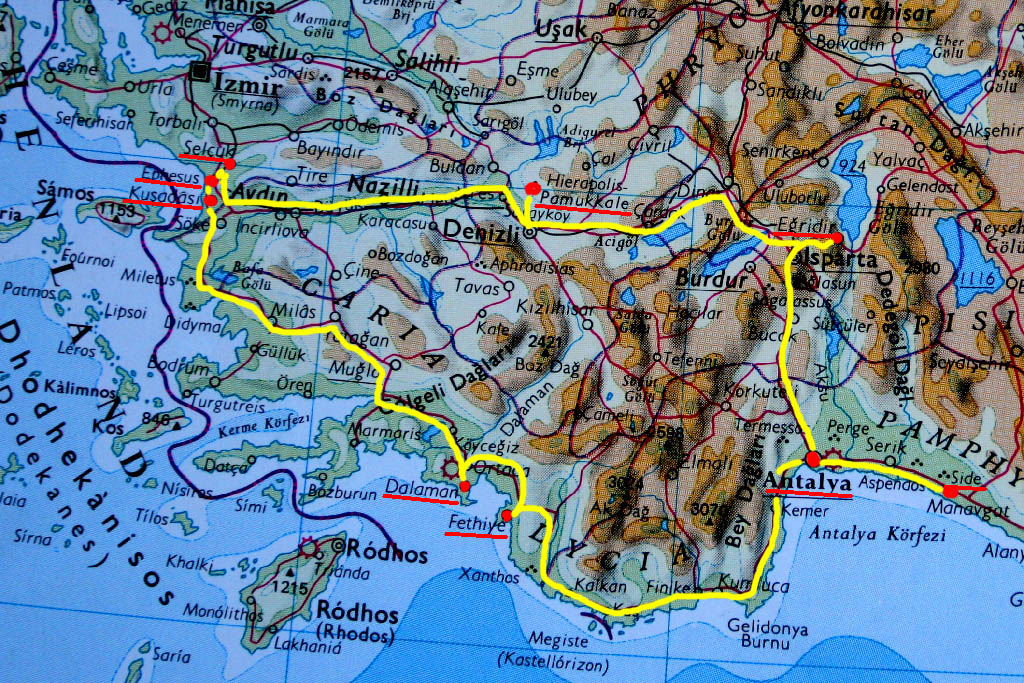
From Cologne to Antalya
One tickets for the flight from Cologne to Antalya did cost 500 DM (almost 250 Euro today). We arrived in the evening and as we were looking around how to get into Antalya town, we were approached by a guy who offered us a free lift to a hotel owned by his "brother". It was the
Hotel Türel
Lara Yolu Caglayan Mah. 2055 Sok
No:39-41 07100 Lara / Antalya
Tel:(31) 231382
|
It was pretty new and a nice place to stay: with clean and modern rooms, a restaurant and a swimming pool ... and a television room.
Oliver was lucky to watch the first world champion soccer game of his country just in time.
Next day, before we headed to Antalya town, we inspected the Lara Beach close by.
Click the small picture to get it enlarged
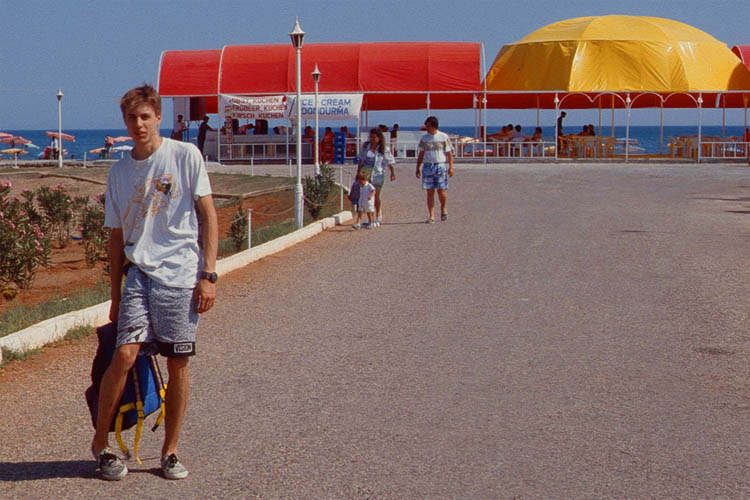
| We are not here for ice cream and cake
|

| Also not to buy real estate
|
Antalya
Antalya is the capital of the province of Antalya and the main tourist center of the "Turkish Riviera". It has a long history and was first mentioned around 200 BC and soon after became part of the Roman empire.
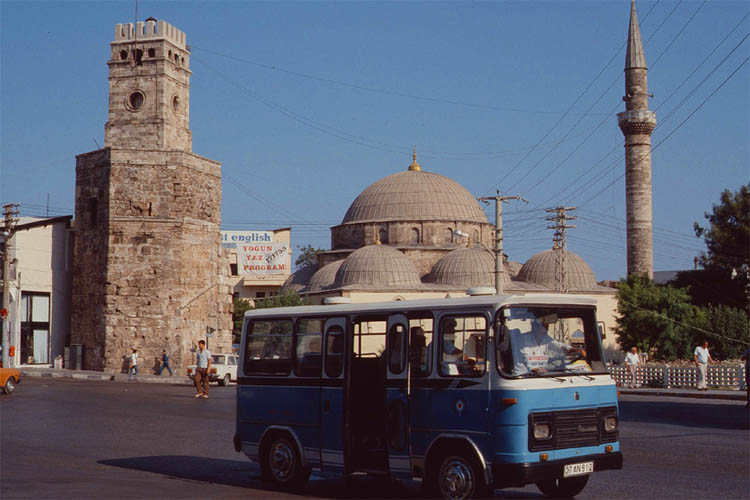
| We came here for the people
|
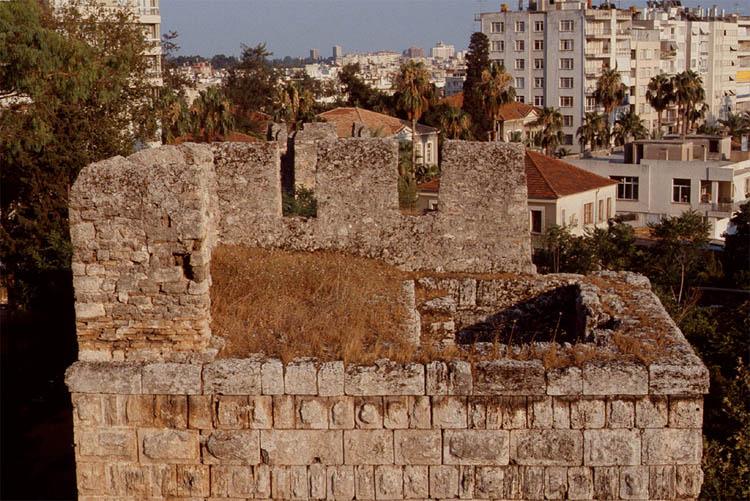
| and to delve into their history
|
Hadrian has visited this city once and has ordered to build new fortifications. One gate is named after him and still standing. Antalya also served as a crusader base in the Middle Age.
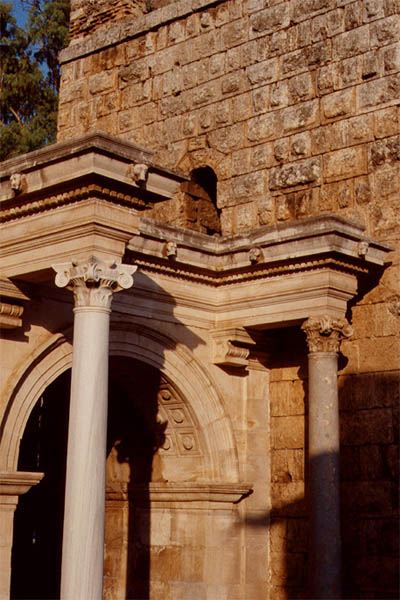
| From the Romans
|

| to the Middle Ages
|
With the "takeover" of Antalya by the Seljuk Turks from the weakening Eastern Roman Empire during the first half of the 13th century, Islam became the dominant religion. The Yivli Minaret was built soon after and is one of the symbols of Antalya.
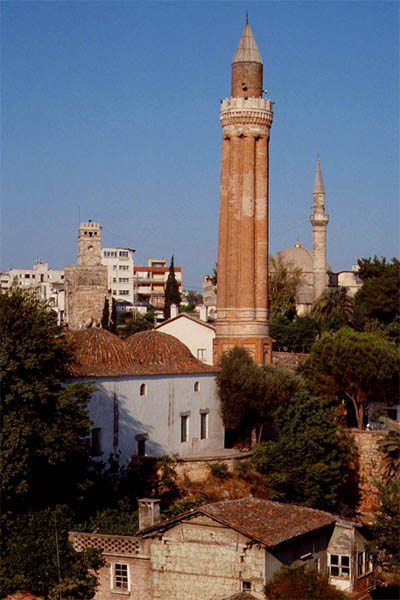
| Experience their religion
|

| Admire their mosques
|
Antalya is a place worth to stay a couple of days. It has many more interesting sights like an archeological museum and a beach close by. Strolling around the harbor and the souk, especially in the evening, is rewarding.
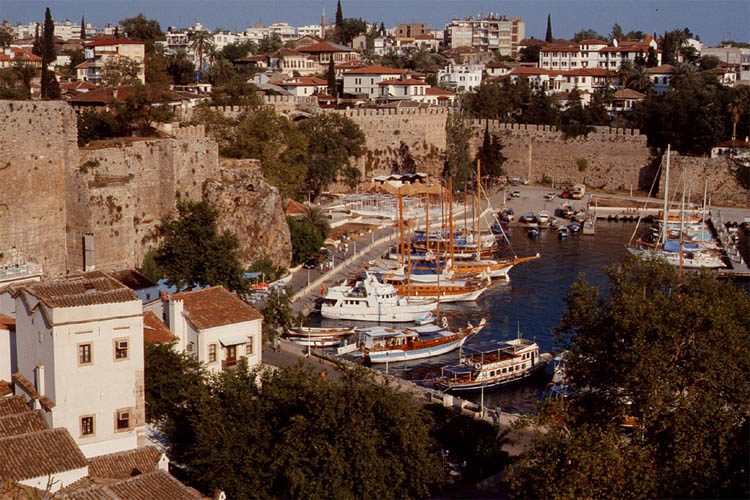
| Antalya has a natural bay
|
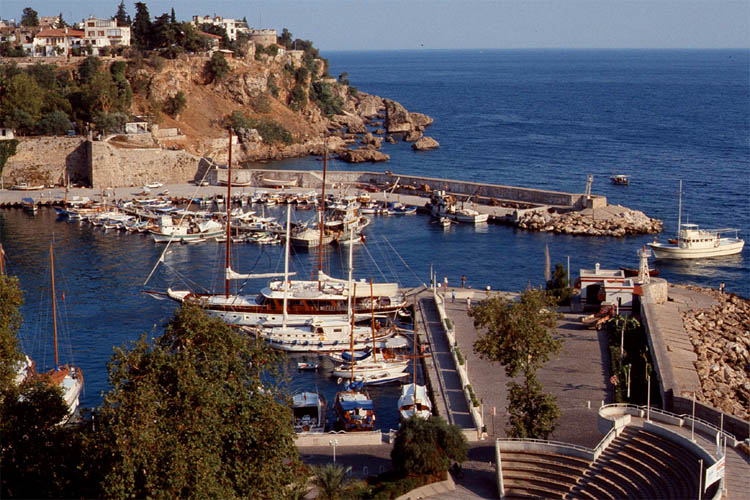
| with a modern yacht harbor
|
There are all kinds of restaurants and accommodations. We settled down in a guesthouse in the old quarter close to the bus terminal.

| Staying in a cheap pension in Antalya
|

| This hotel bar seems to be closed down
|
Egredir
Early next morning we hopped on a bus and after around 150km up north we arrived in Egredir, a nice town on the shore of an even nicer lake of the same name.
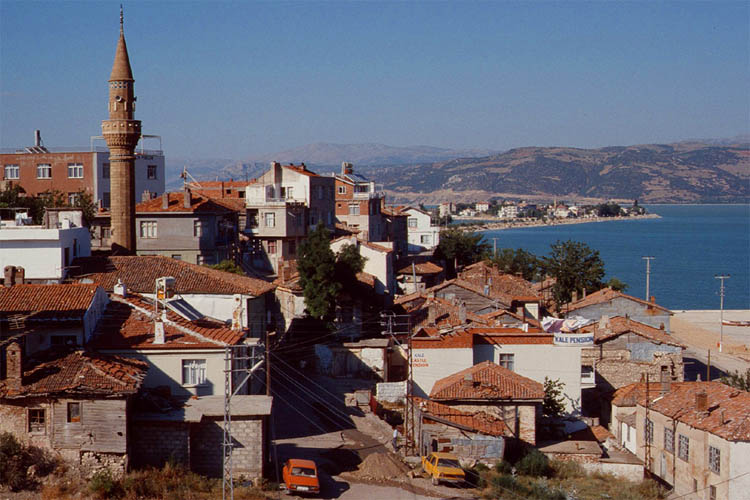
| From Antalya city to Egredir town
|
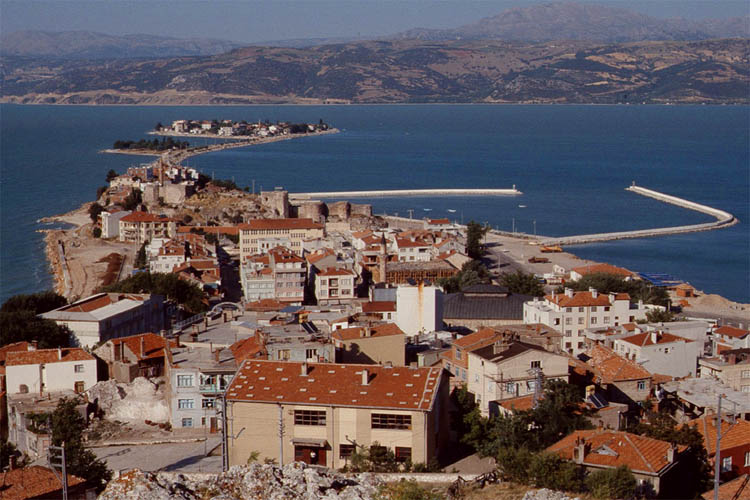
| From the sea to the Egredir lake
|
Here we "lived" with a fisher's family who had a couple of rooms for rent. And the fisherman and his son also invited us for a fishing trip on the lake.
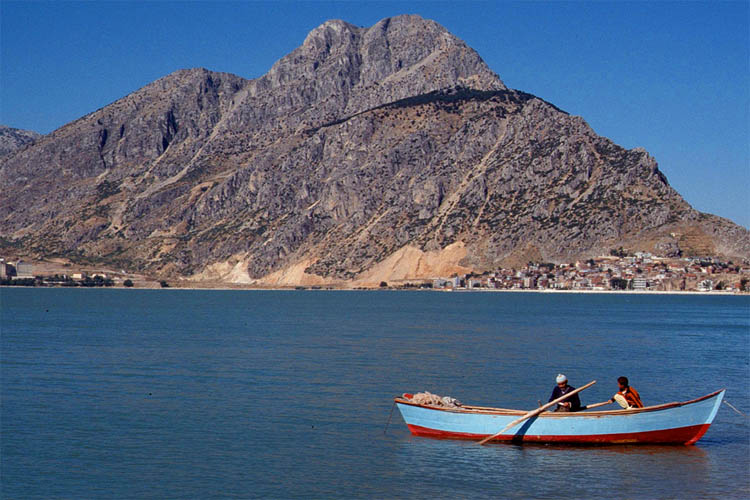
| What a beautiful lake
|
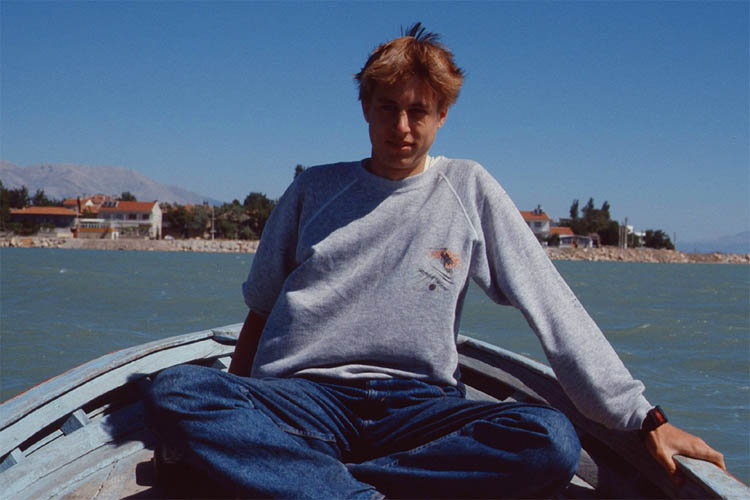
| Going on a fishing trip
|
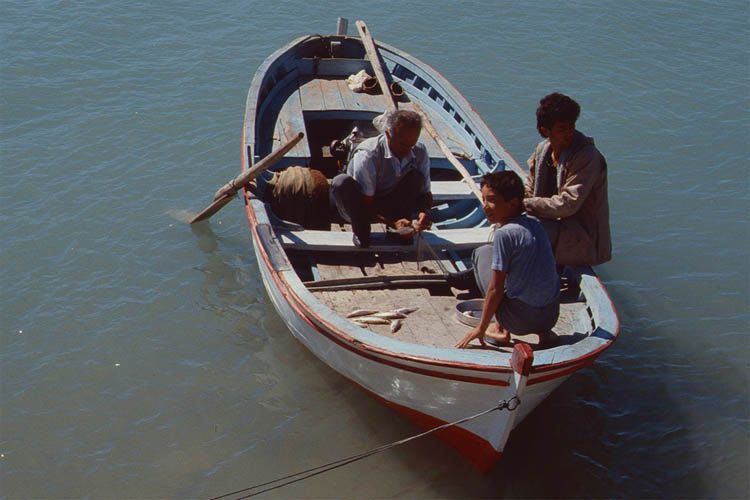
| Counting the fresh catch
|

| And presenting it proudly
|
Pamukkale
Next day we took a public bus again and after around 200km to the west we reached Pamukkale. As soon as we arrived at the bus terminal we were already welcomed by a bunch of touts trying to lure us to all kinds of accommodations. We joined a German speaking young man who offered us to stay in his guesthouse. He grew up in Bavaria and eventually moved back to Turkey together with his parents who invested their Deutschmark savings in the booming hotel business (that actually was the original idea of the German government that all "guest workers" will someday go back to their home country, but millions of Turks decided that it would be better to stay in Germany).
What about this place with the booming tourism industry? We soon found out after we walked to one of the most interesting spots in Turkey. I have not seen anything like that in the world: the natural white sinter terraces glistening in the sun with white milky water. That's also where Pamukkale gets its name from: Cotton Palace.
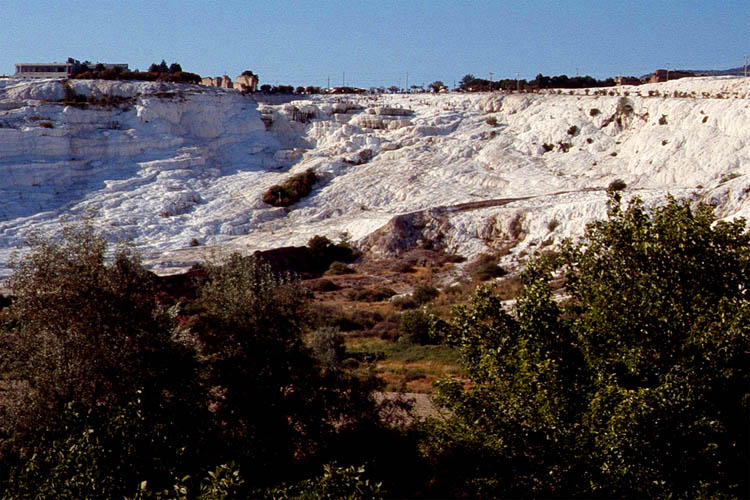
| The sinter terraces of Pamukkale
|
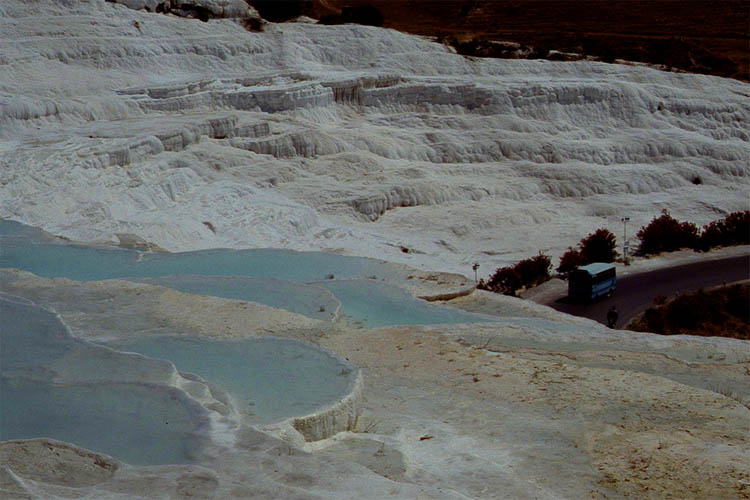
| Easily to be reached on the road
|
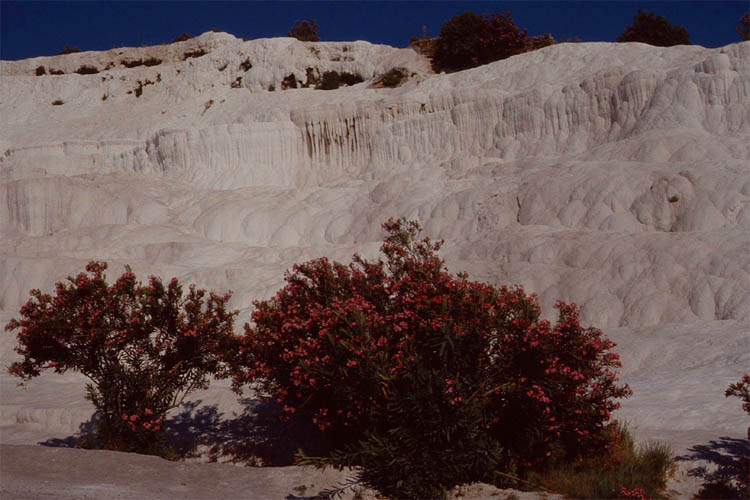
| Oleander blooming in the snow?
|
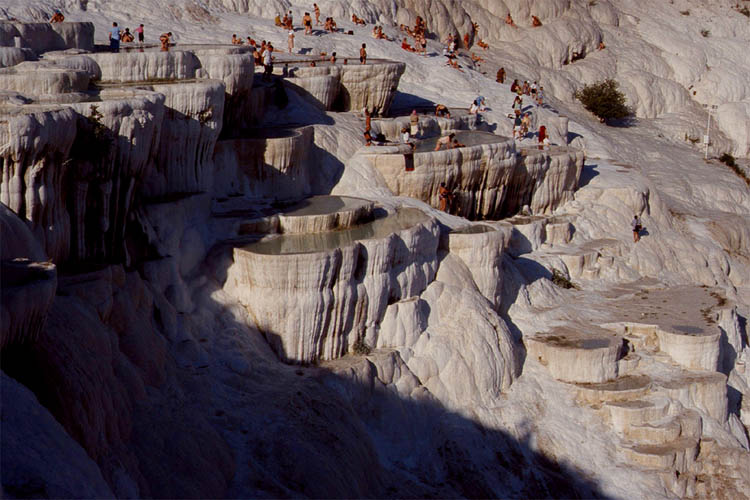
| People swimming in icy water?
|
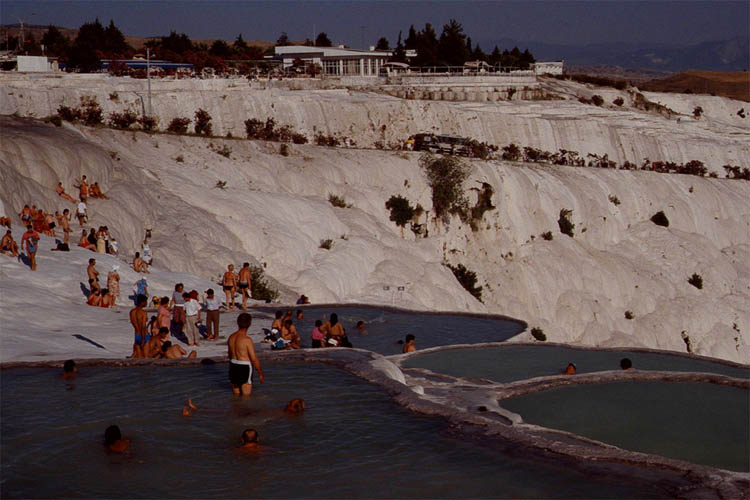
| But it's summer and hot
|
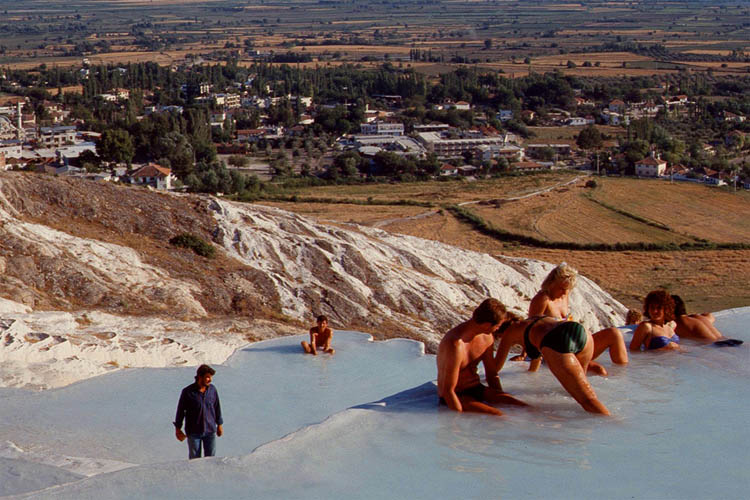
| And the water is like in a bathtub
|
But we are not only here for fun (yet) but also for learning and teaching history to my son. It was easy to find our way because the antique Roman site was close by.

| But first we followed the old rubble
|

| And then really found a marble
|
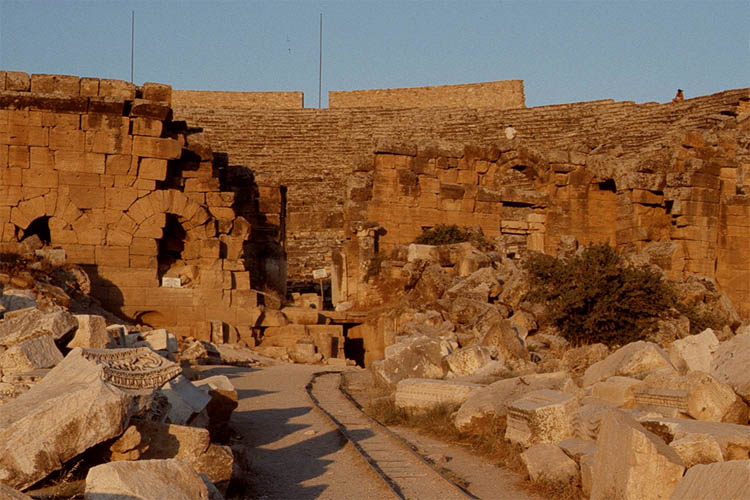
| Getting closer
|
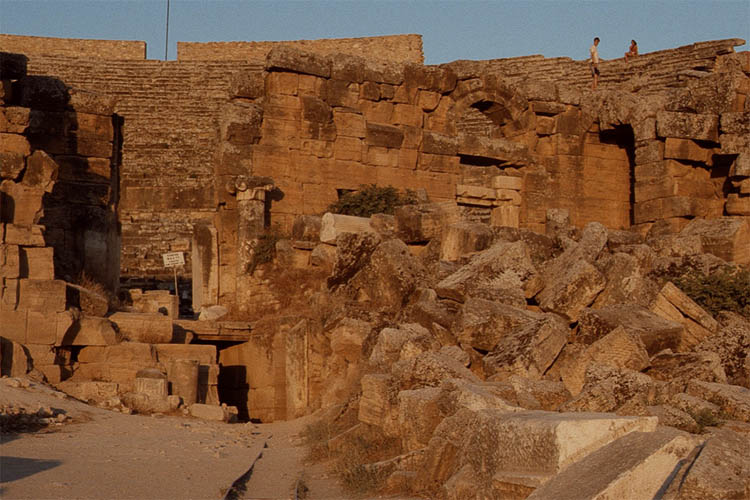
| and closer
|
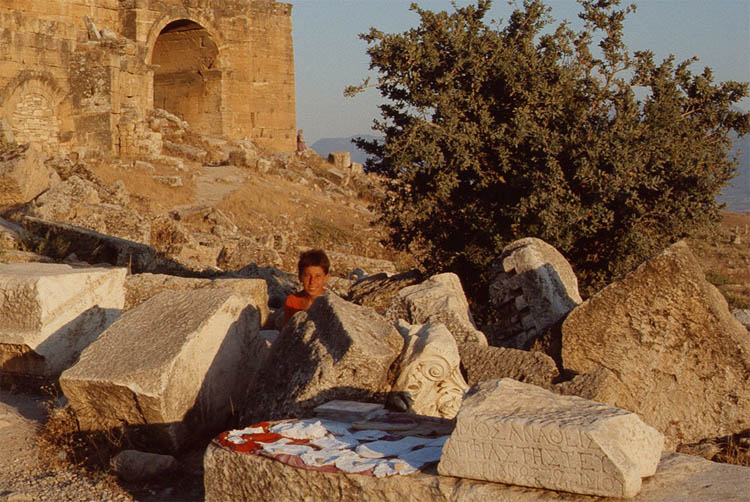
| We don't want a souvenir
|
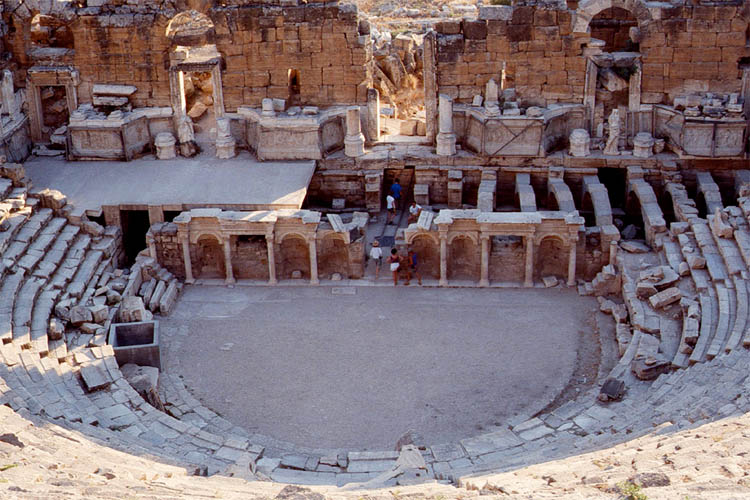
| We want to see the theatre
|
This place also was fantastic. Natural wonders and historical sites so close together. Yes, the old Greeks and the Romans knew where it is best to live: location, location, location. And this location was called Hierapolis.
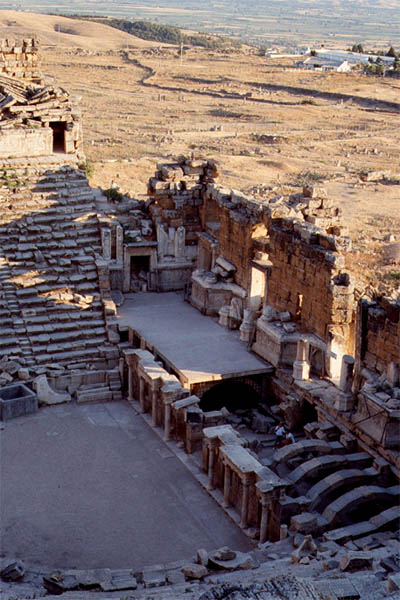
| What a view down
|
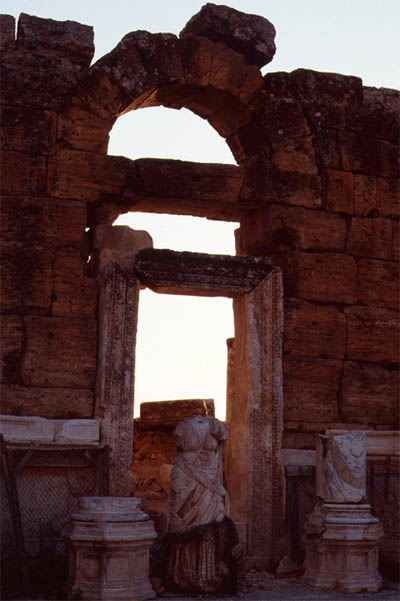
| and a look up
|
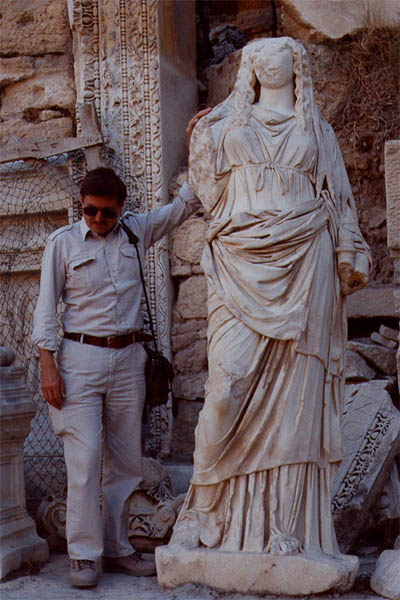
| What's there to see?
|
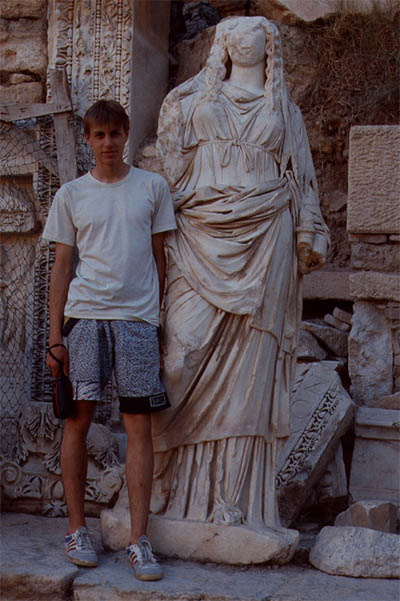
| He better looks at me
|
There is a Roman saying "To see Rome and die". Why? Because Rome has nice grave sites? Actually the Romans had them everywhere, also here in Hierapolis.
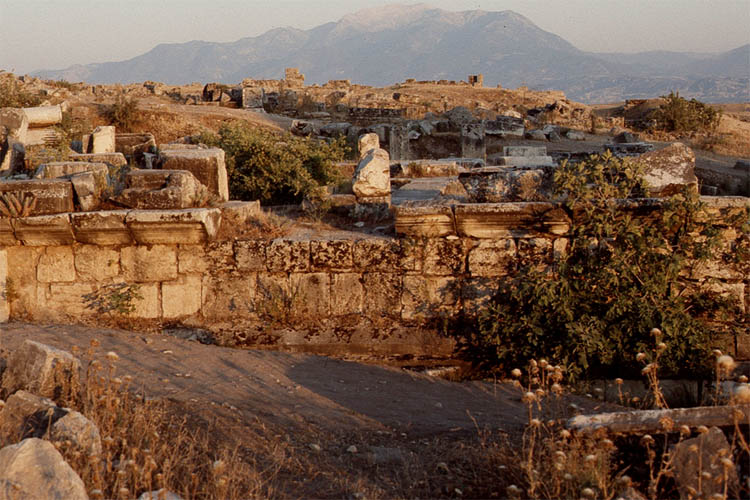
| What's behind the wall?
|
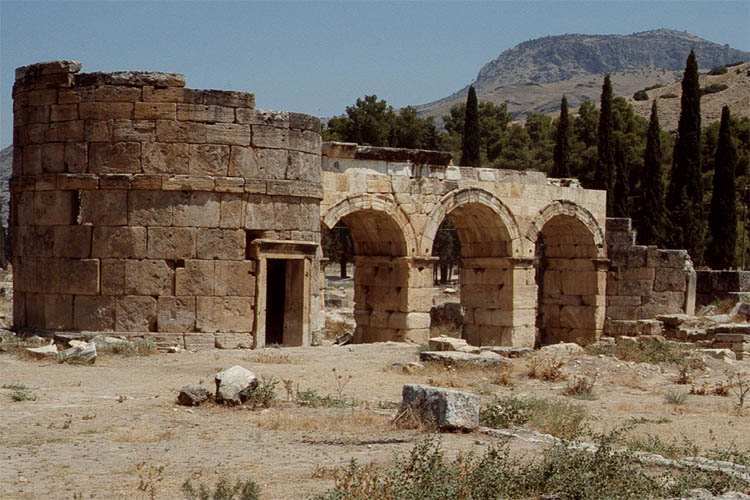
| What's behind the gate?
|
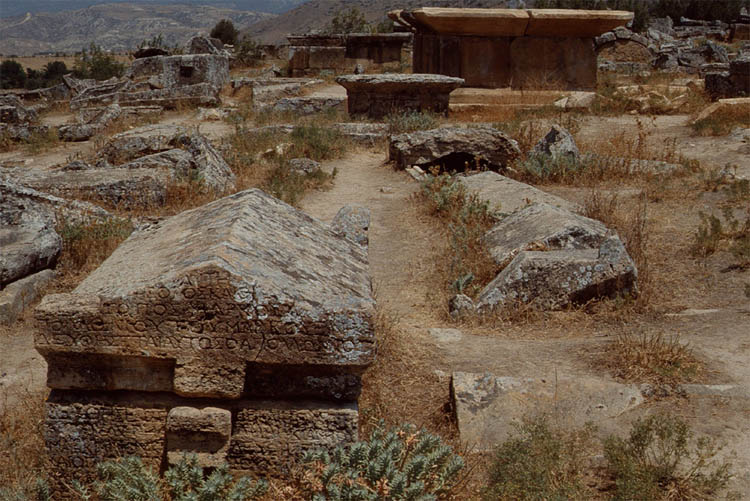
| A cemetery, or better: necropolis
|
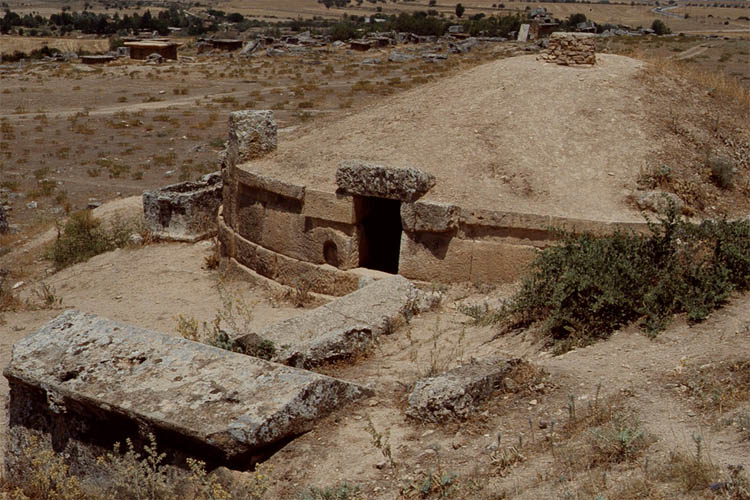
| Here must lie a famous Roman
|
From a spring on top of the hill the water spills over the terraces. Maybe a thermae was built here in Roman times. The remnants were probably used to build a hotel around. What a pity.
But at least in the crystal clear water of the hotel swimming pool you can see some old Roman columns lying on the floor. Oliver jumped in and swam around until the hotel guard chased him out because that was only reserved for hotel guests. And now there is no hotel anymore because it had to be demolished and removed to recreate the original landscape. Good so.

| And now we found Atlantis?
|
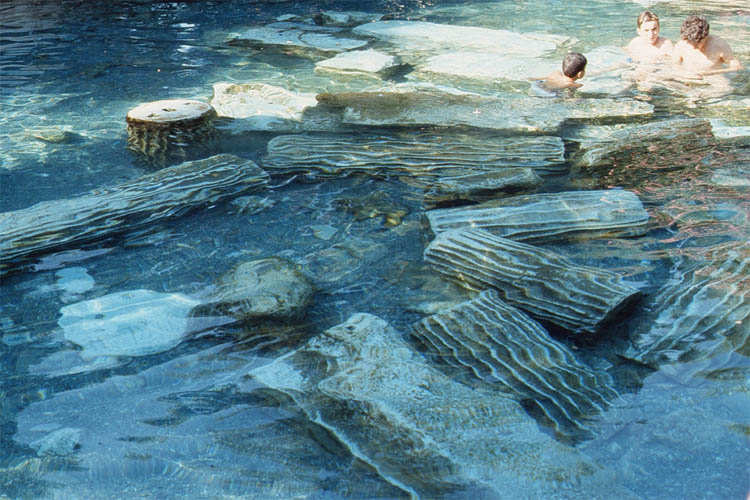
| No, it's a hotel swimming pool
|
So we rather took a bath in the sinter pools. And that was real fun. Besides, it was also very healthy because the water had a lot of healing properties.
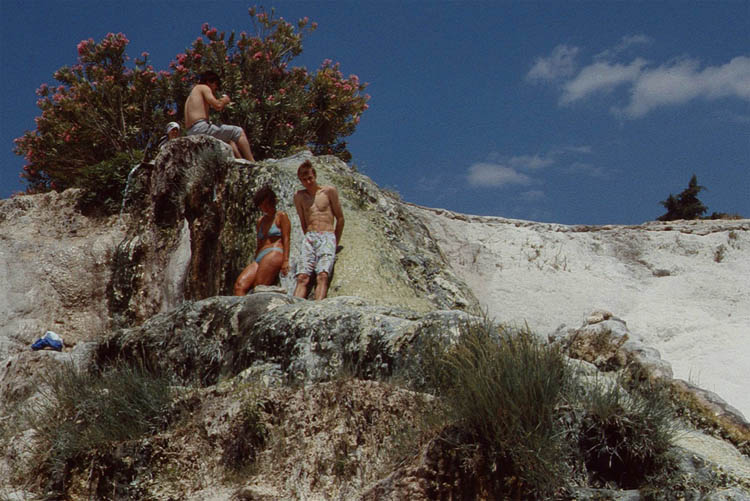
| Going down the slope
|
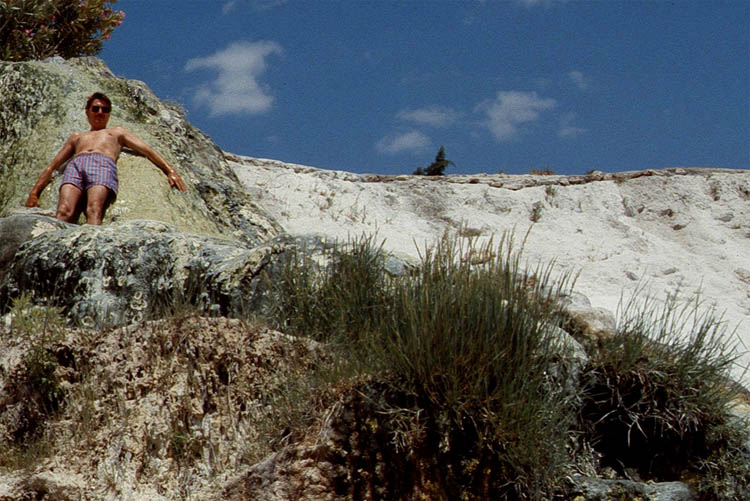
| to the natural pools
|

| Or sliding down
|
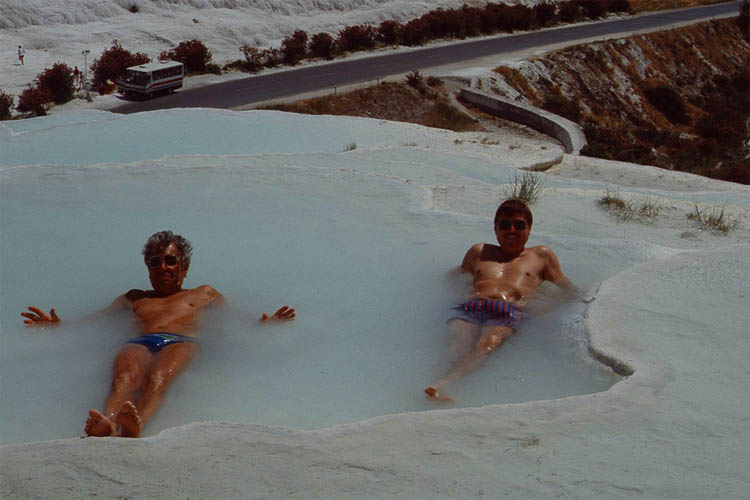
| into the milky water
|
Ephesus
Unfortunately we had to leave Pamukkale, because our time was limited and we wanted to see much much more. The distances we traveled during the day were not so long but the public buses take a long time, stopping in every little town. It was interesting though. So after almost 250km we were going to see another highlight: Ephesus. The next town was Selçuk where we stayed overnight.
We could have taken some kind of transport to the main entrance of the archeological site but I had a nice area map and it didn't seem very far so we walked. Somehow we missed any entrance to get our tickets and all of a sudden we were right between the ruins.
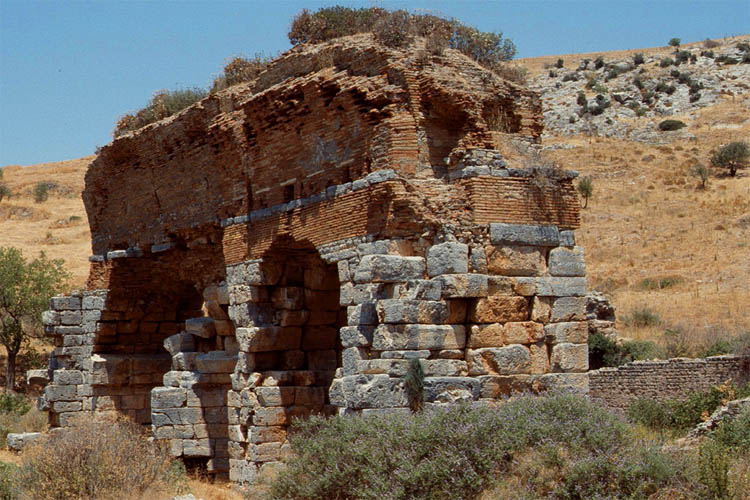
| Ephesus through the back door
|
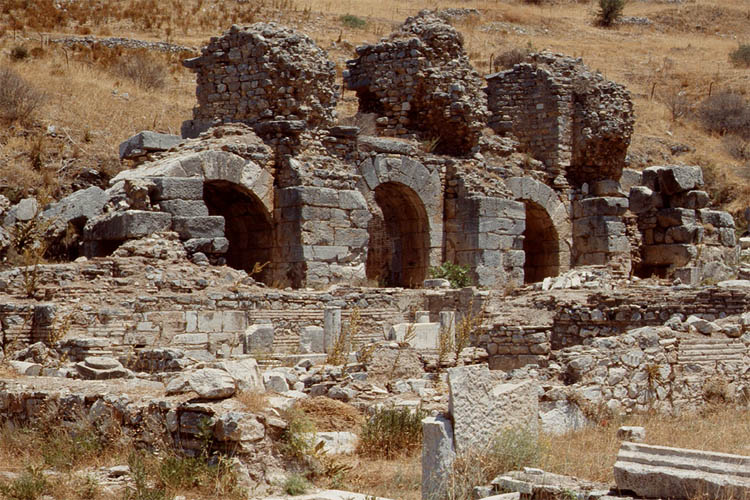
| where are the nice temples?
|
Ephesus was probably founded in the 11th century BC by the Greek. "Ownership" alternated between various factions of the Greeks with the Persians then via the Romans to the Goth and back to the Byzantine Romans and finally the Seljuk Turks until it was abandoned in the 14th century. Each of them either destroyed part of the city or constructed new buildings, like temples, churches and fortifications.
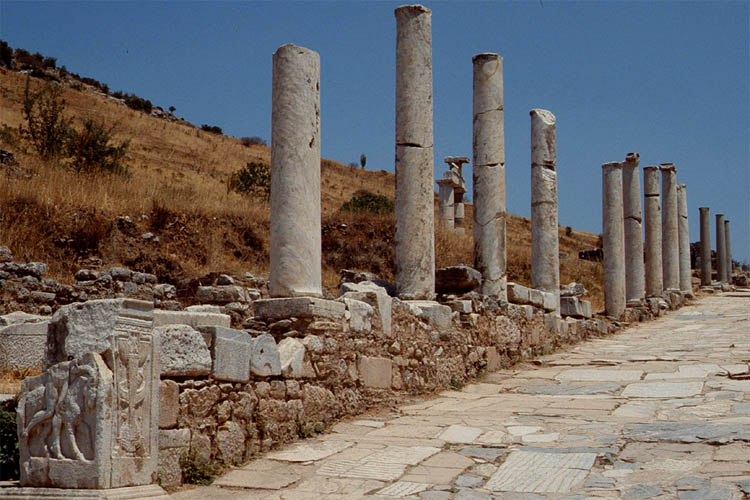
| This road must lead somewhere
|
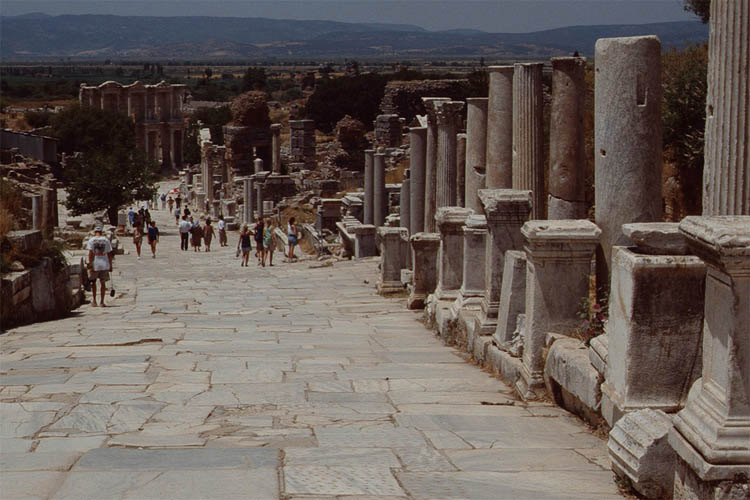
| Yes, all the way down to the real city
|
You may wonder how well preserved some of the artifacts are, considering that this site was a ghost town and overgrown for more than 400 years. The first excavation was started by an English guy in the year 1863.
The temple with the gate as shown below was built around the year 130 by the Roman emperor Hadrian.
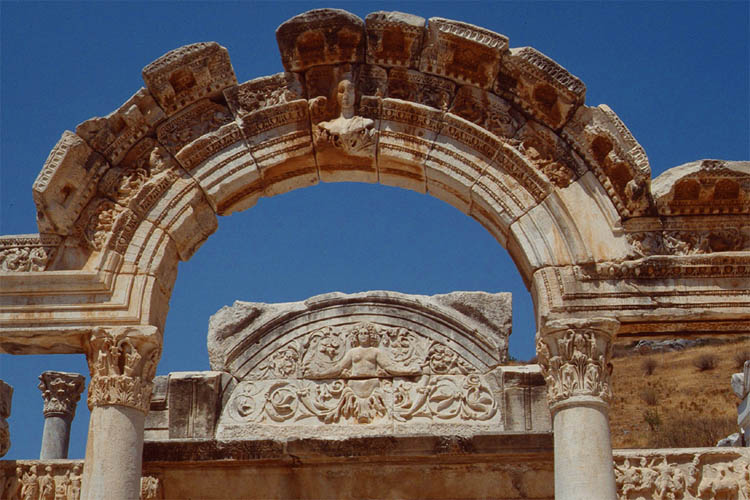
| An intricate gate to a temple
|

| with supporting colums
|
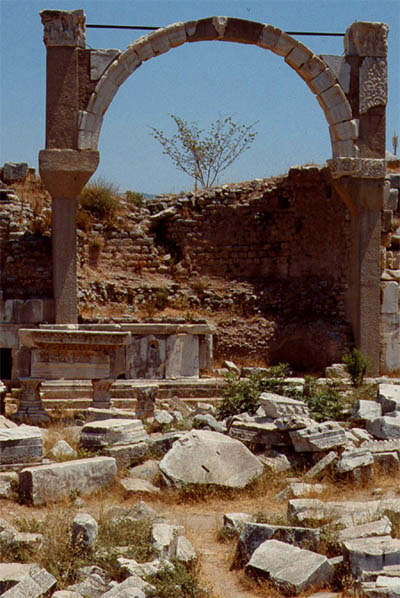
| Some old gates
|
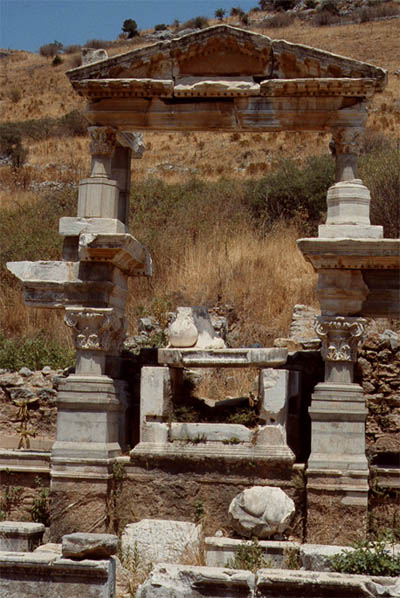
| had been re-erected
|
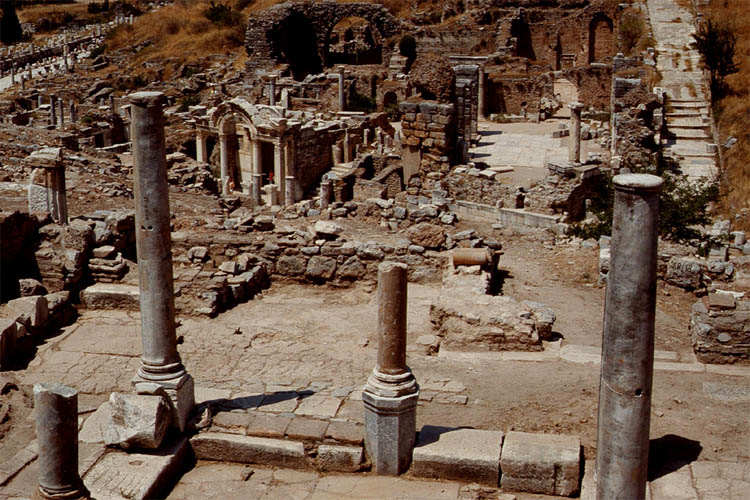
| But there is still
|

| much to be done
|
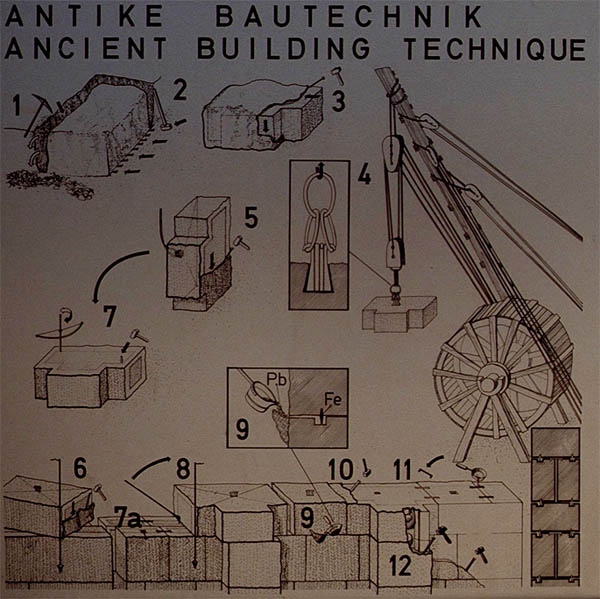
| How was it all built?
|
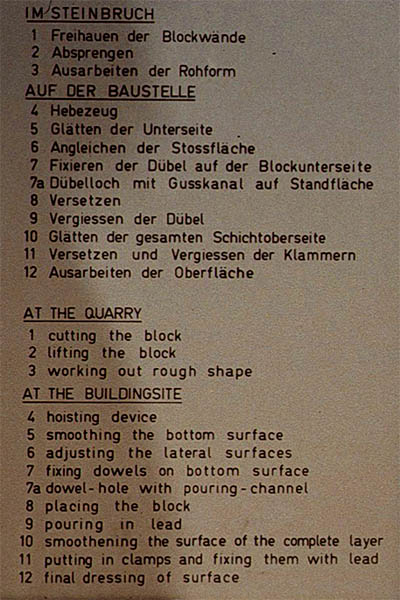
| Just read the instructions
|
The following pictures will also show some examples of the comfortable life style of its inhabitants. You can encounter the same standard in many other Roman places, like in the Provence (see my previous travel report).
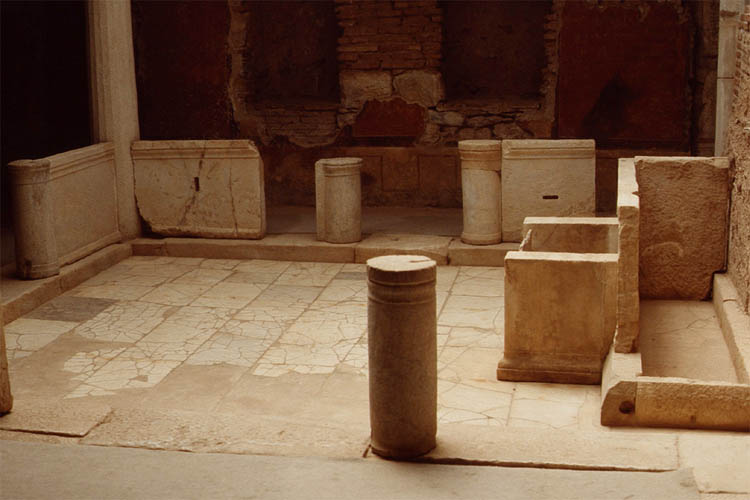
| Comfortable living style
|
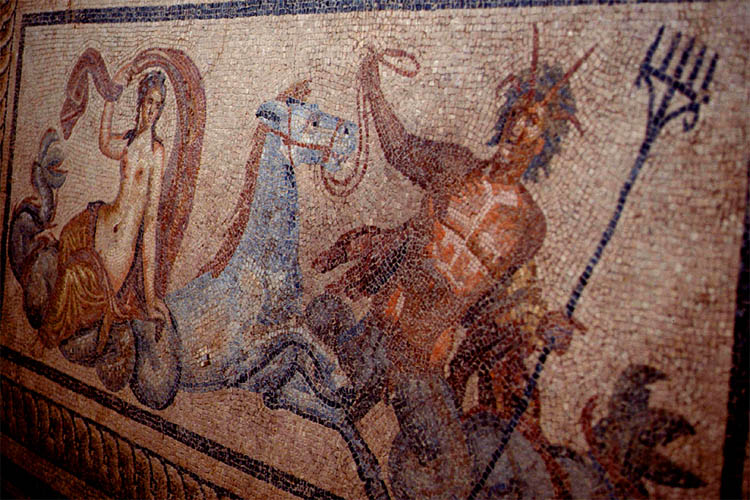
| surrounded by art
|

| Eating and drinking well
|
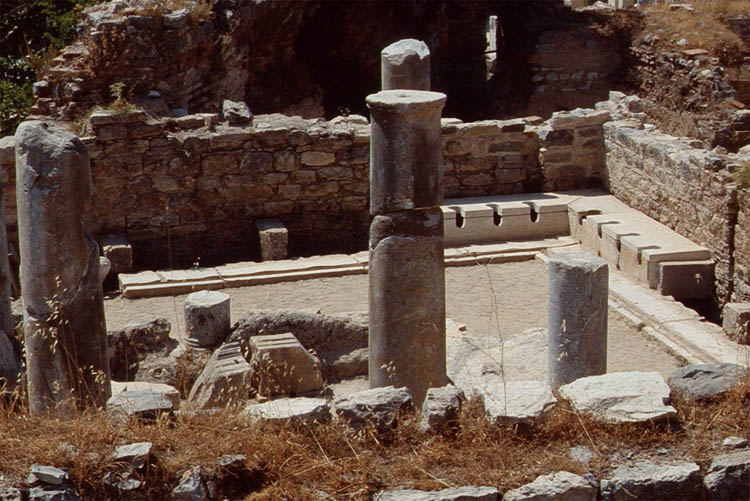
| Also to relieve oneself
|

| This looks like a Roman thermae
|
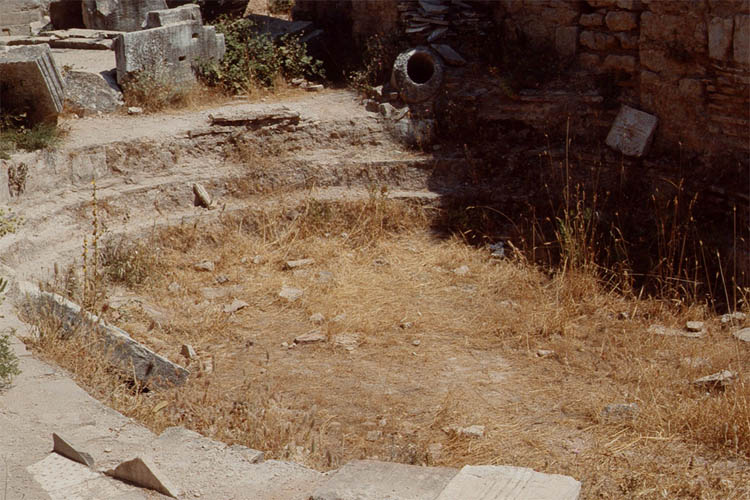
| with an ancient pool
|
Then we came to the biggest construction: the obligatory amphitheater found in almost every Roman town. The view from the top is always magnificent.
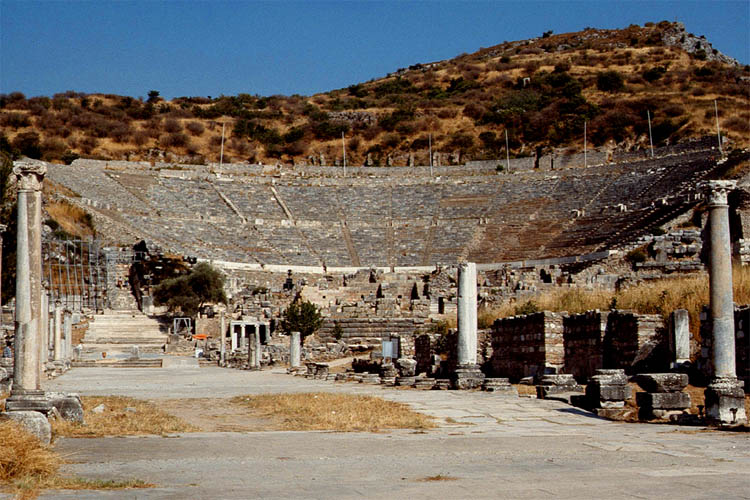
| The highlight
|
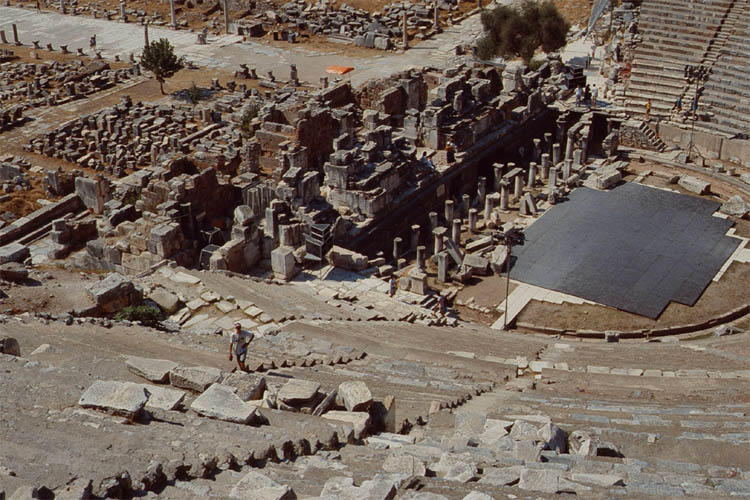
| The amphitheater
|
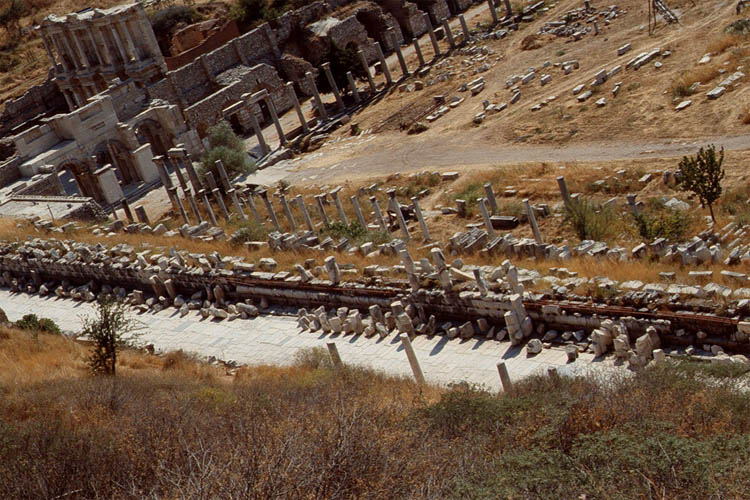
| Looking down
|

| Looking back
|
Then we came to the end of our archeological tour at the official entrance. Not much time to relax now, because we were offered a lift back to Selçuk right away.
Selçuk
It was a nice ride in a big American car driven by a cool looking Turkish guy. Did we do the right thing to jump into his cruise ship? He looked like a drug dealer but he was only a carpet dealer. Back in town we had to inspect his carpet collection. If we would have bought one, maybe he would have invited us for a seafood dinner.
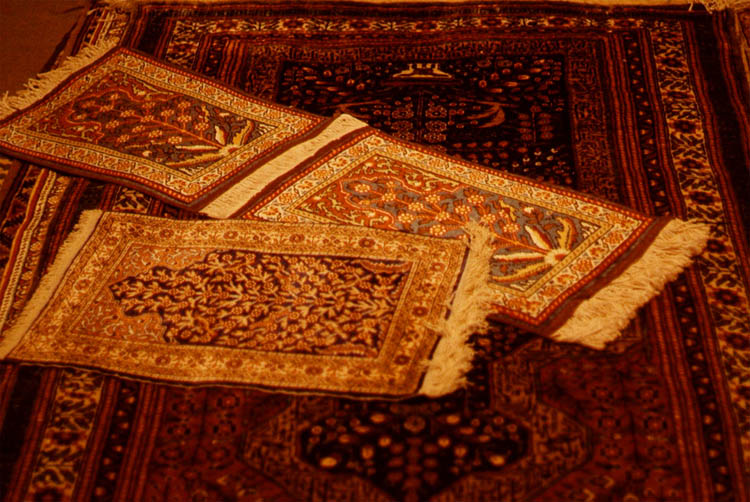
| Back to town with the carpet tout
|
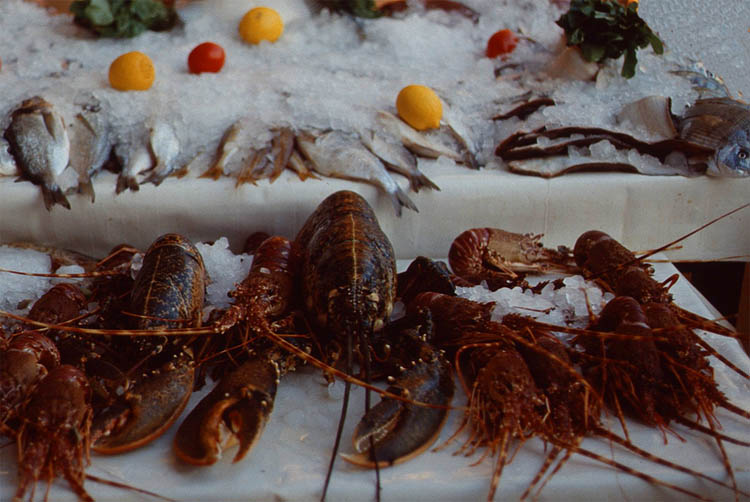
| Shall we eat lobster or trout?
|
It is a must to visit the archeological museum, where all the "loose" artifacts, excavated in Ephesus and around, are shown.
Especially famous are the Artemis statues from the second century BC. She is the Greek goddess of hunt (Diana is the equivalent Roman goddess). The Artemis temple in Ephesus was once one of the "Seven Wonders of the World", built in the third century BC but destroyed by the Goth in the year 263.
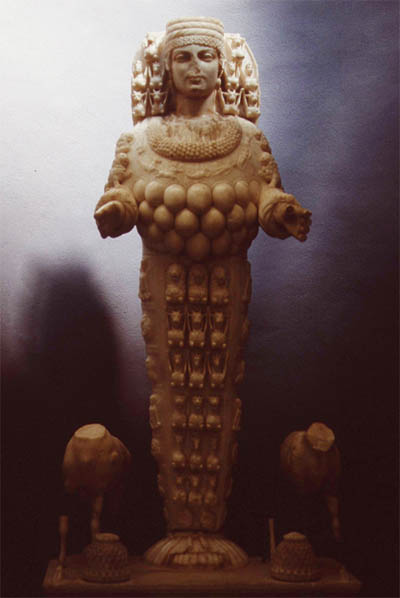
| This is a statue of the Greek goddess Artemis
|

| This torso looks like the Roman goddess Venus
|
Dalaman
It was only a short ride of 20km from Seljuk to Kusadasi, where we stayed one night. This town was facing the Aegean Sea and thus had a harbor for ships going to many other places along the coast, even to Istanbul. But we continued down south by bus the next morning and after almost 300km we reached Dalaman.
This town was a tourist spot. Not only for foreigners but also for many Turks. And you need a boat to get to the interesting places. But where could we hire one? We asked a guy on a boat and he was so kind to invite us to join him and his friends.
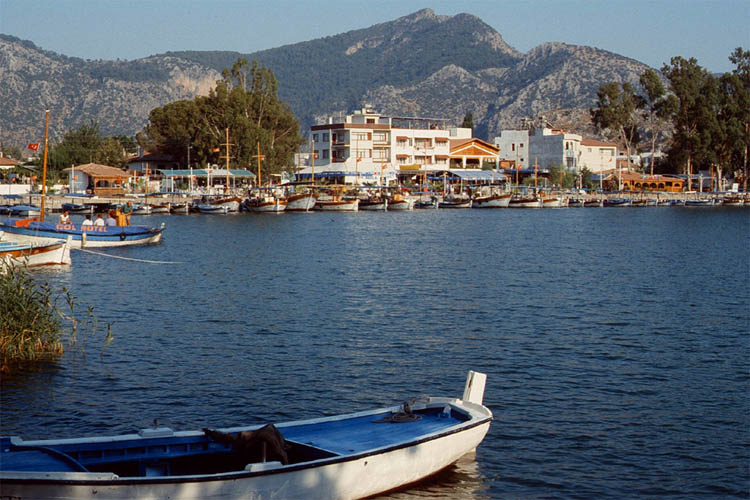
| Going on a cruise in Dalaman
|
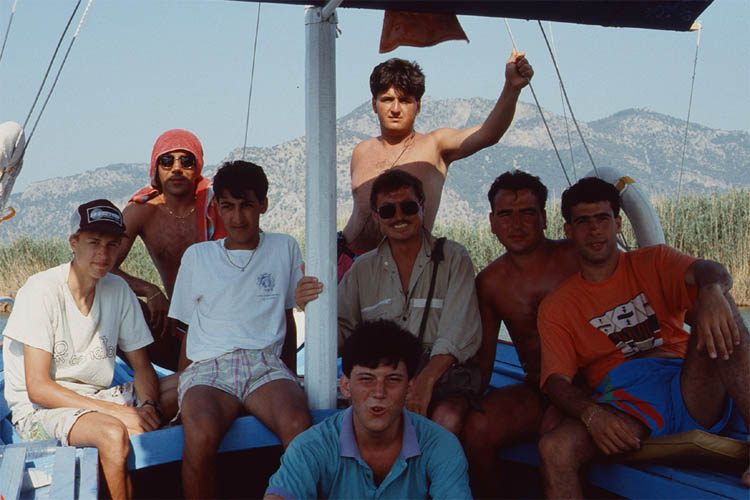
| Our new Turkish friends and we
|
Dalaman was located at a lake connected farther west with the sea. While we were cruising along the coast of that lake we saw graves dug high up into the rocks. Then we landed at an archeological site. I don't remember the name but I will still find out. It looked like another Roman settlement, also with the obligatory amphitheater again.
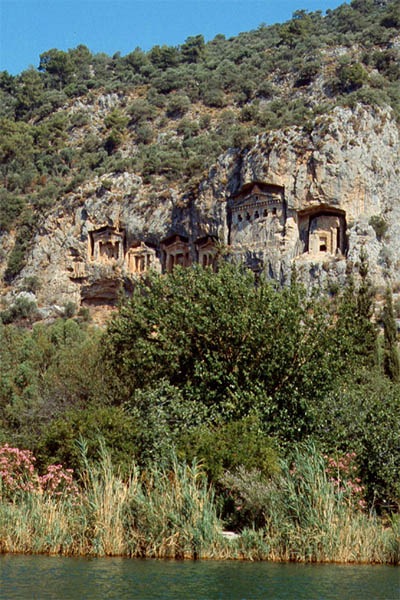
| Passing by ???
|
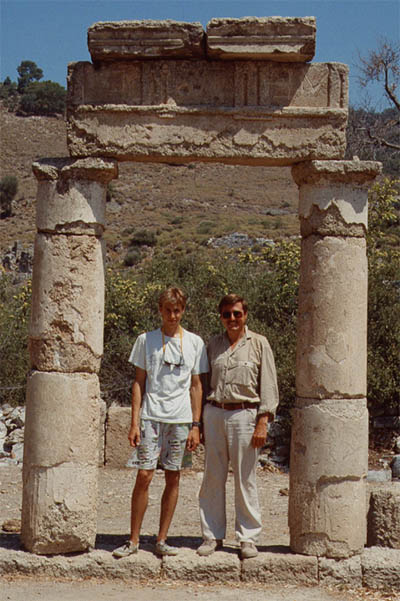
| Landing on ???
|
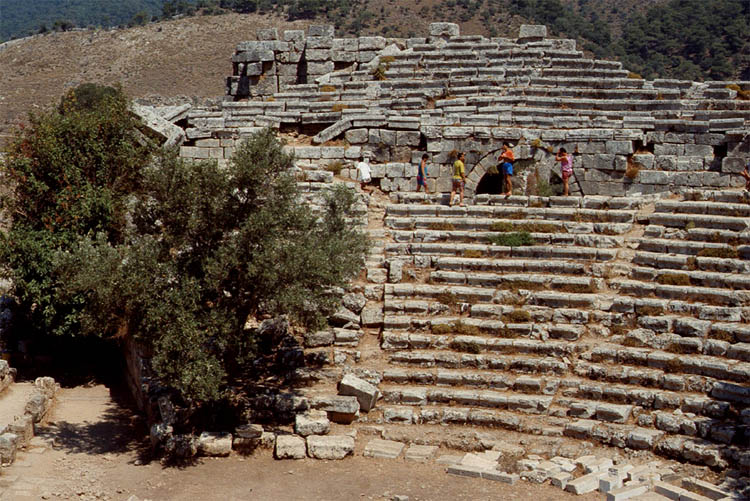
| Another amphi-theater
|
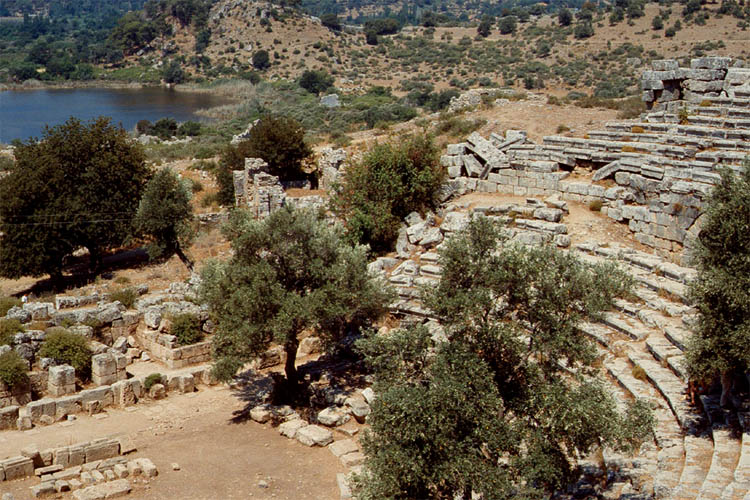
| of another Roman settlement
|
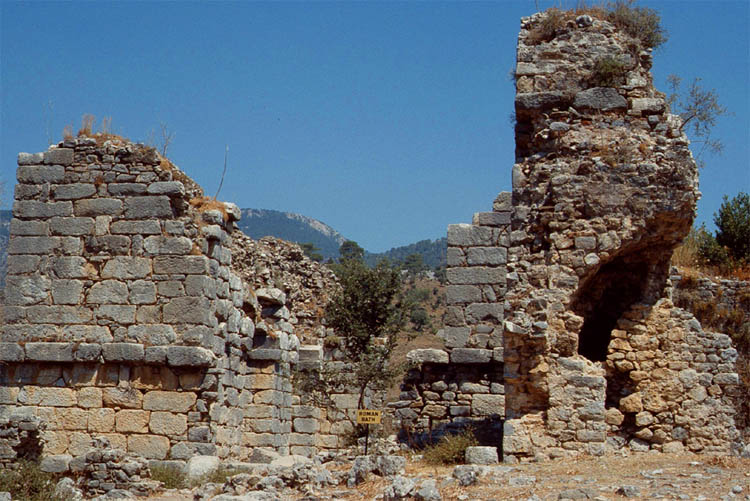
| All the houses are ruins
|
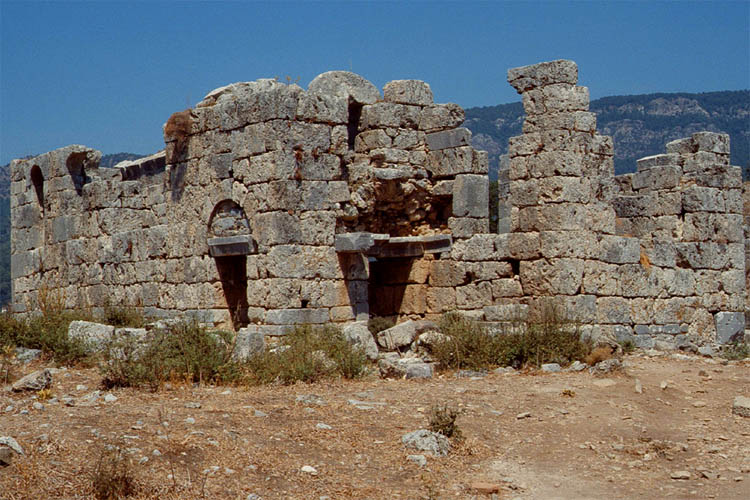
| but some walls are still standing
|
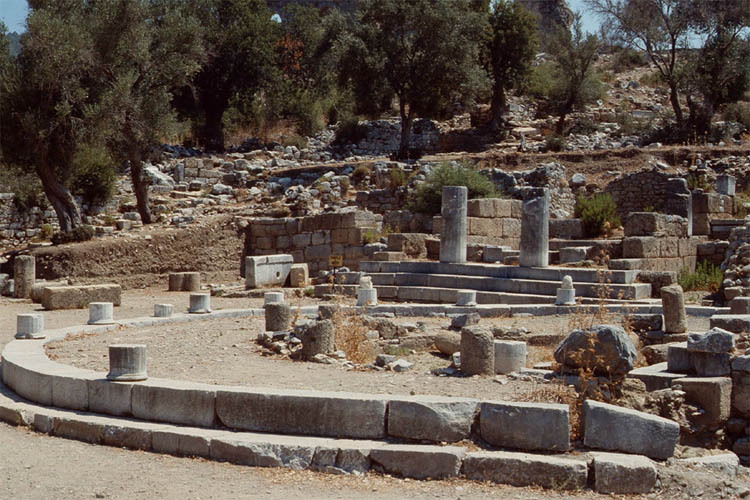
| No archeologists are digging anymore
|
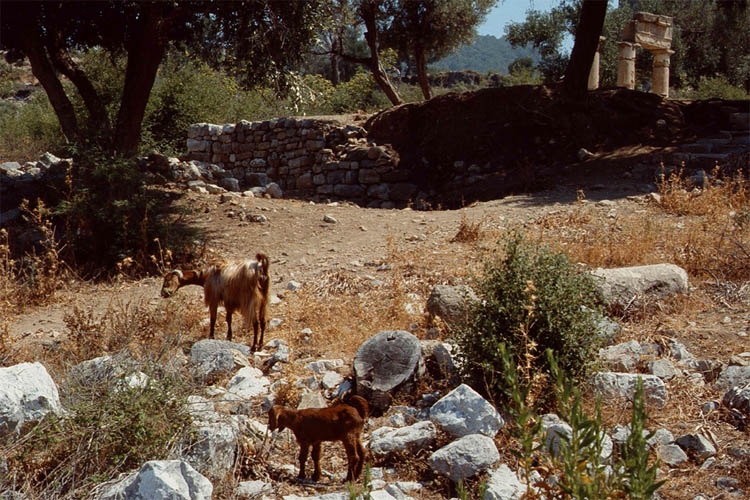
| only goats are grazing between the rubble
|
Then we landed at the end of the lake to walk over a dune to reach the sea. While our Turkish friends were swimming in the sea and frolicking in the sand, we strolled along the mile long beach to the south till the end. We saw traces of a sea turtle probably having laid its eggs deep into the sand.
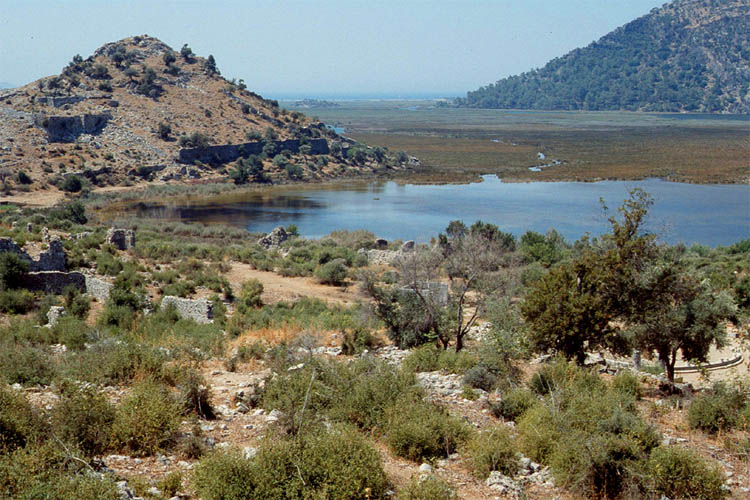
| Do you see the sea far behind the lake
|
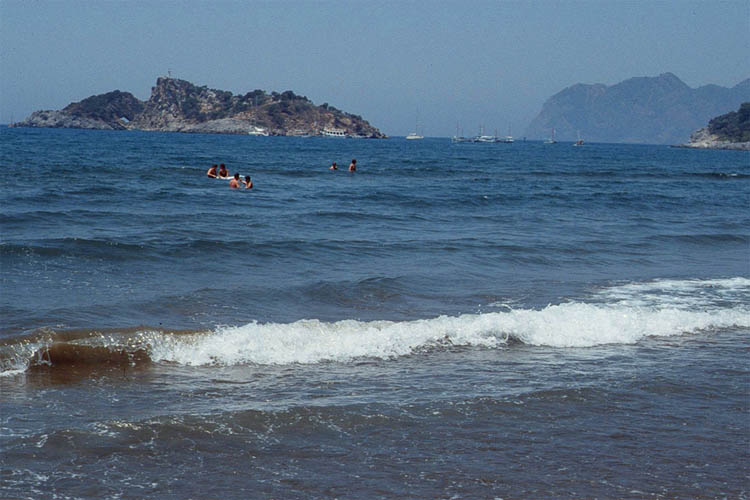
| Could have swum but strolled along the beach
|
In the evening we had dinner and a good time together with our Turkish friends in one of the many restaurants along the pier of Dalaman. We even did get a lift with their truck/bus to our next destination about 60km down south: Ölü Deniz.
A really nice place. One of best and picturesque beaches in Turkey. Everybody seemed to know that, because all the hotels were fully booked. After we relaxed a little on the beach we took the bus to Fethiye which was just around the corner from this beautiful laguna.
But, oh my God, no available rooms either. One hotel owner felt pity for us and offered us to sleep on his roof of his 4-story building. We accepted. Two beds were moved up with bedding. Bathroom was one flight down the stairs. And it was a wonderful night under the sky. In the morning we woke up with the sun. The view around and to the harbor was fantastic. Soon we were ready to get finally back to Antalya with the next bus and the last stretch of around 250km to complete our round trip.
The Waterfall of the River Düden
Now we had plenty of time to explore the vicinity of Antalya. I had already seen something spectacular from the airplane. A huge waterfall plunging right into the ocean. I have not seen anything like that before.
Now I want to get as close as possible. Looking just from above was not enough. I wanted to get down. There was a hidden steep path along the right side of the fall. You had to watch out not to fall. Then down there it was fantastic. Take a look at the following photos to be convinced.
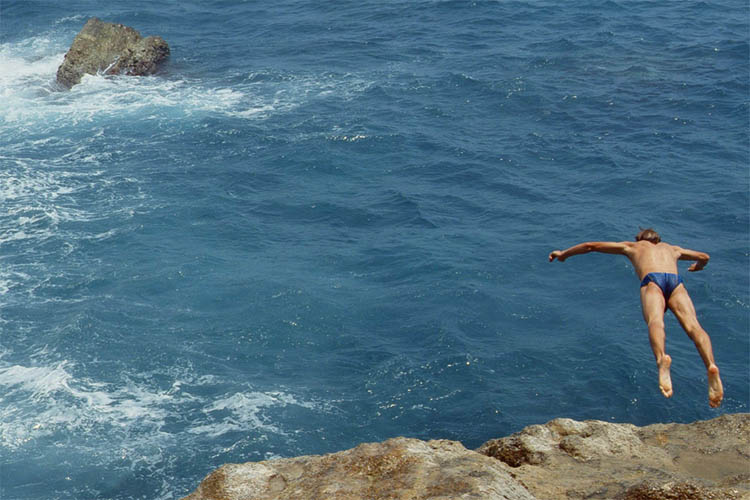
| Oliver is jumping into the sea daringly
|

| and tries to swim against the current bravely
|
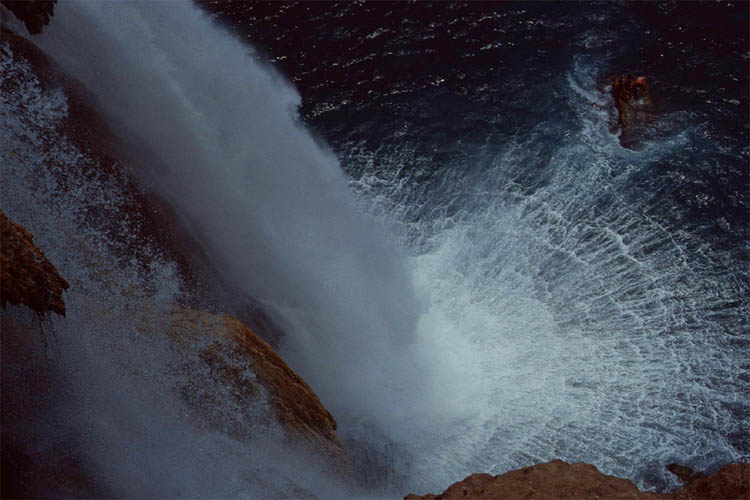
| The current of the waterfall is really strong
|
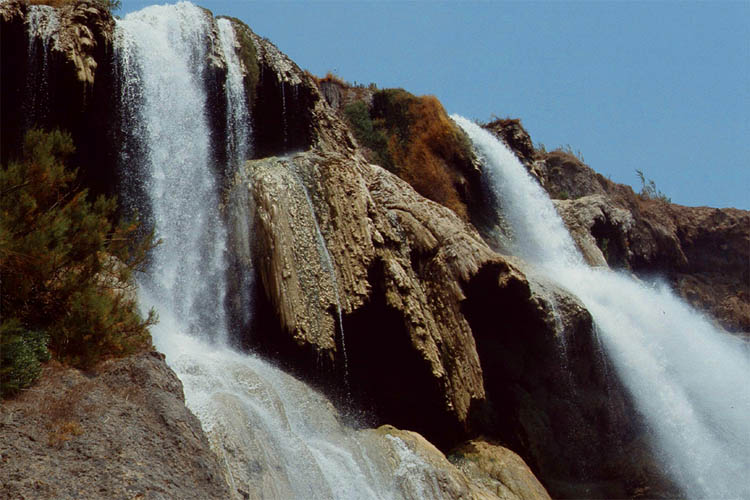
| From 80 meters the stream comes down
|
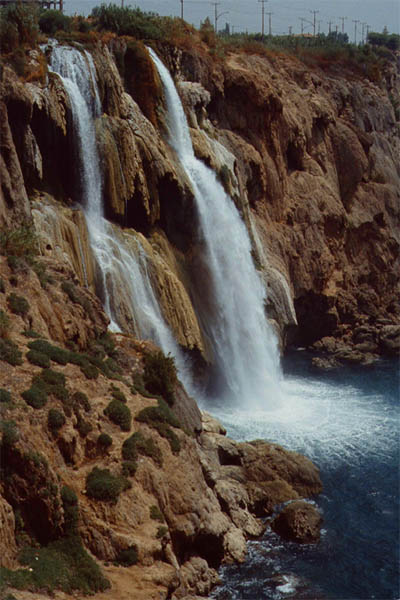
| Here you see the whole waterfall
|
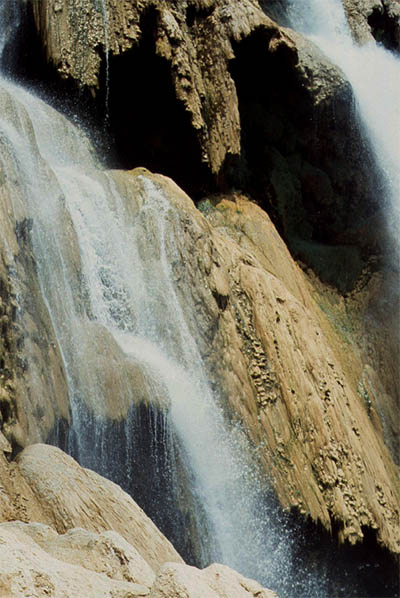
| And a small part of it all
|
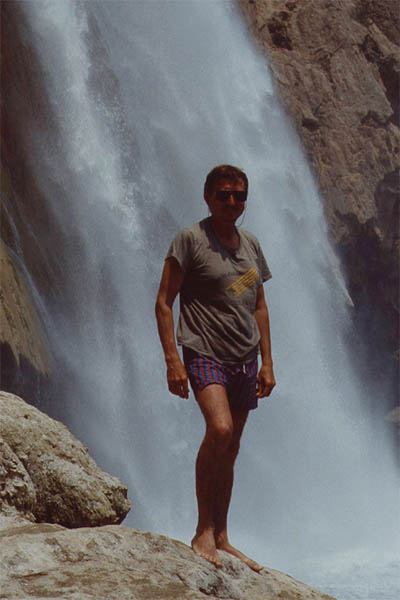
| After the swim we did boast about it
|

| but we were both really exhausted
|
The River Düden
After experiencing the waterfall we wanted to know where the water is coming from. Not to be carried from there over the rim but to admire the river Düden carrying so much water. We heard about an interesting landscape along that river where also a lot of Turkish families gather on the weekend to picnic and to have fun.

| The bank of the Düden river
|
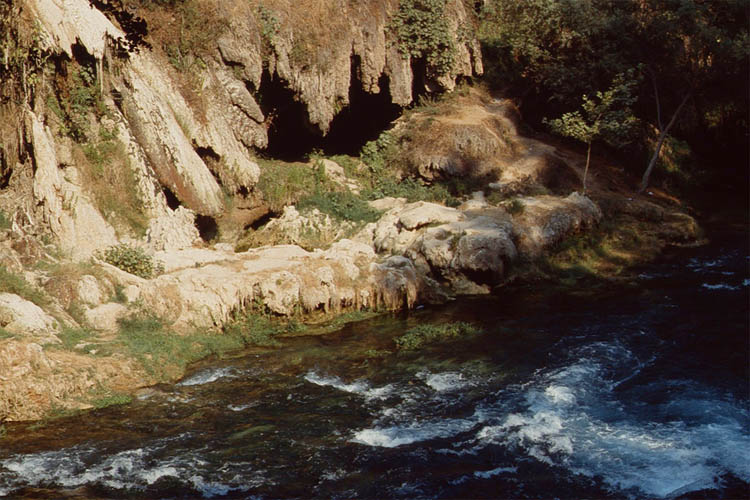
| The small rapids only ripple
|
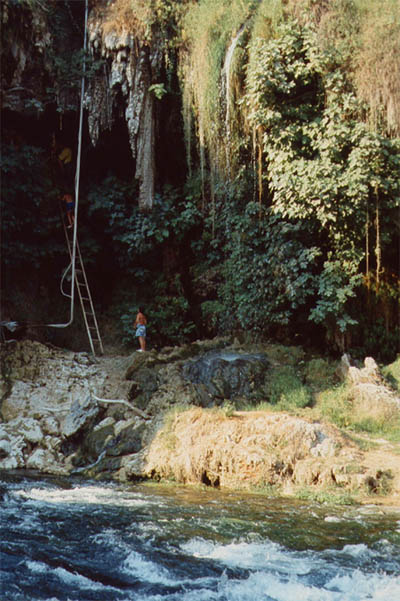
| It's also like descending to the underworld
|

| And some trees are looking out of this world
|
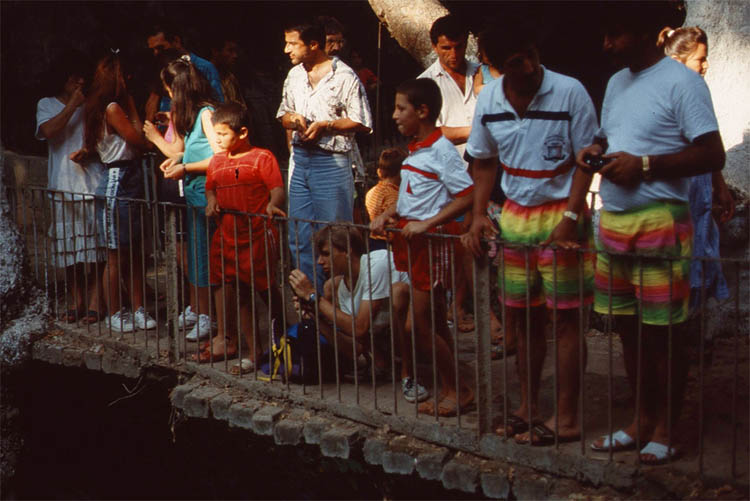
| Are the people seeing other strange things?
|

| This is also a place for family gatherings
|
Side
Another excursion led us to Side, located on a rocky peninsula around 60km to the east. It was and is a fantastic location again. From the old Greek and Roman settlement in the middle to the new tourist summer retreat with beaches at each side.
The impressive amphitheater caught my eyes, the biggest in southern Minor Asia. Unbelievable that Side has been forgotten a whole millennium until a small village was populated again nearby around the 19th century. Excavation of old Side commenced in the year 1947.
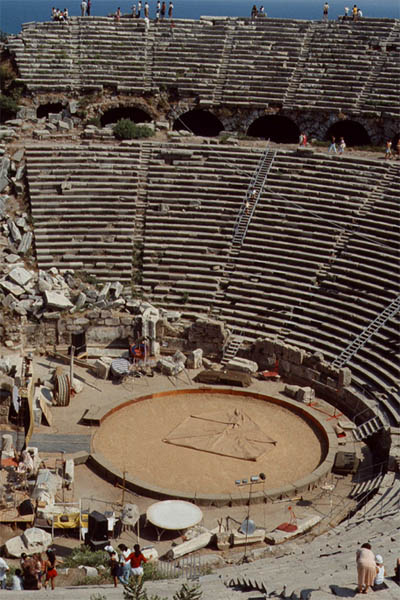
| This amphitheater is still pretty much intact
|
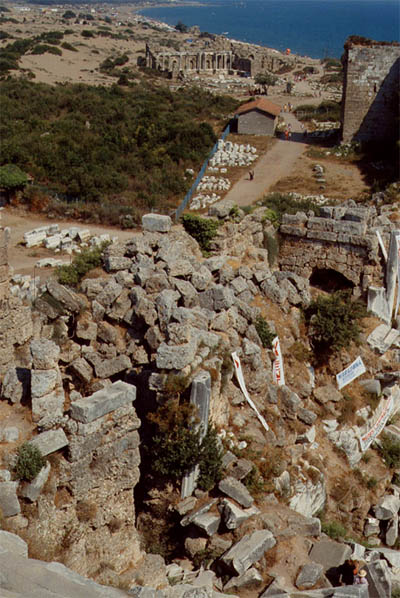
| Even if some walls around are defect
|
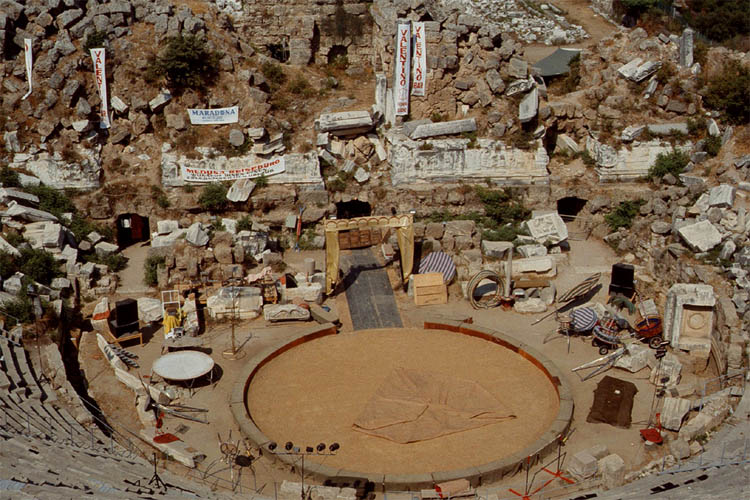
| It already serves now as some kind of a circus
|

| A nice view to the beach, beside the commercials
|
Many beautiful statues and other artifacts have been found during the excavation and are now displayed in the museum in Side. Why was it all left behind? There had been no art lovers anymore? Nobody was interested to erect the naked Three Graces in his home. Ok, I would understand to leave coffins where they are.
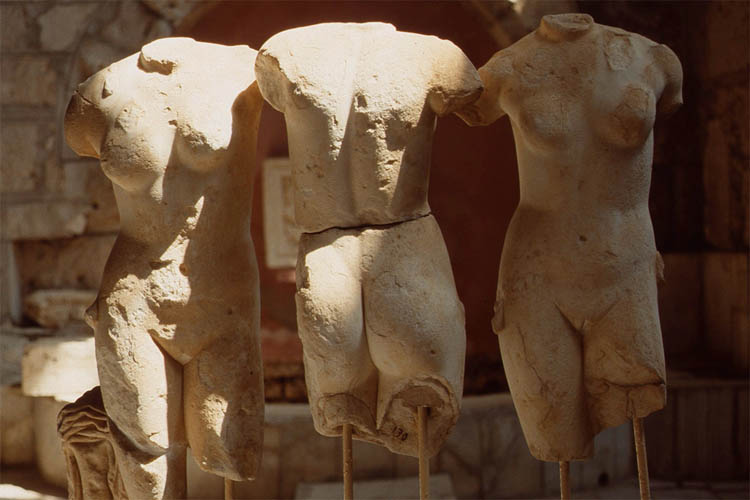
| Back to other artifacts
|

| The other two backs
|

| Old man with a perfect torso but a missing leg
|
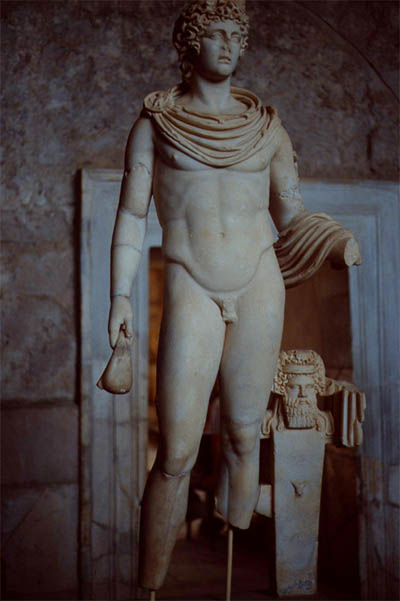
| Young nice man even misses more than that
|
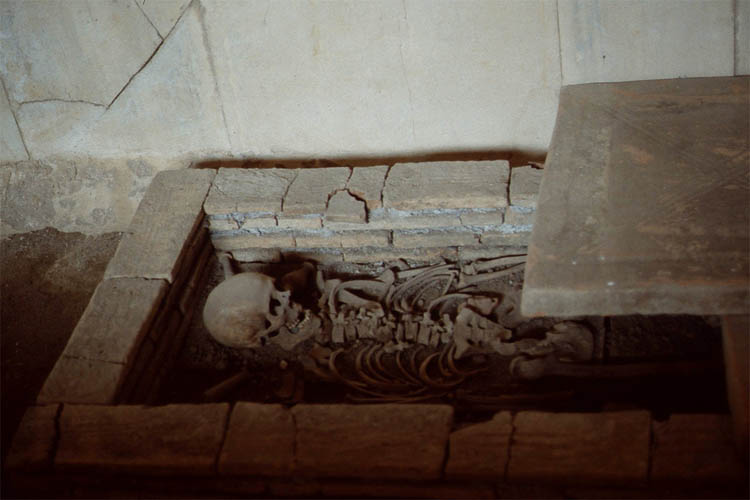
| This poor man is really dead
|
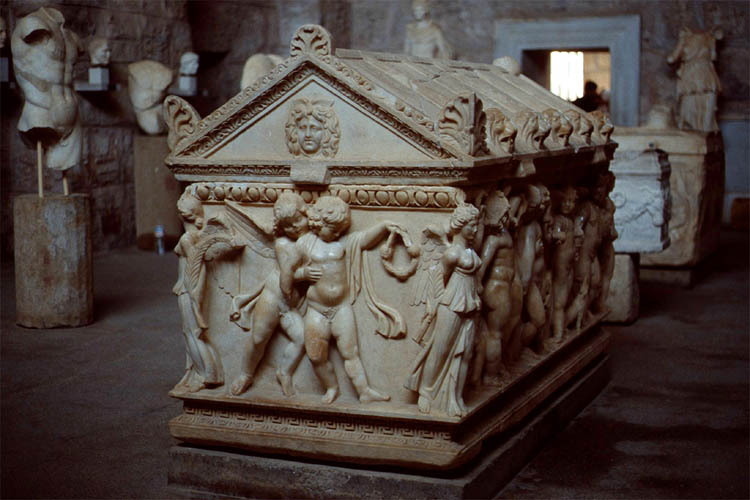
| The rich had a sarcophagus like that
|
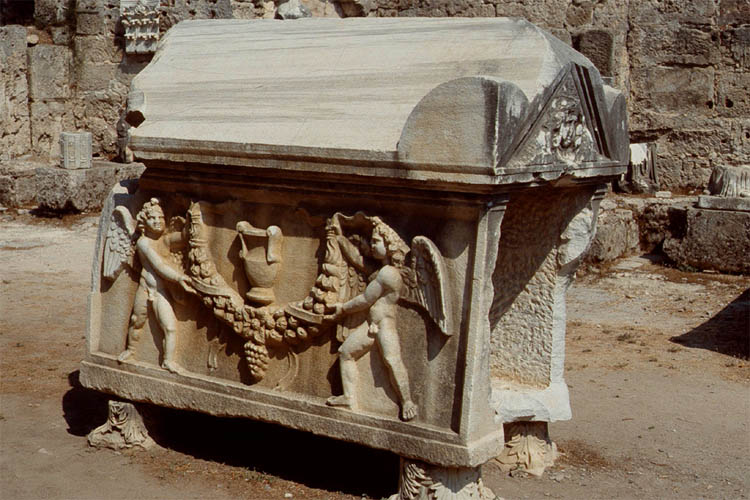
| A grave robber did not care about the dead
|

| Vandalism also didn't stop at any artifact
|
The Cliffs of Antalya
Now back to Antalya. The beach to the west from the harbor was not so inviting to lie down for a bath in the sun or a swim in the water but the view from the cliffs to the east were fantastic also to climb around. Jumping down from high up was not advised but going down the stairs to swim would have been another choice.

| A nice view to the Antalya beach
|
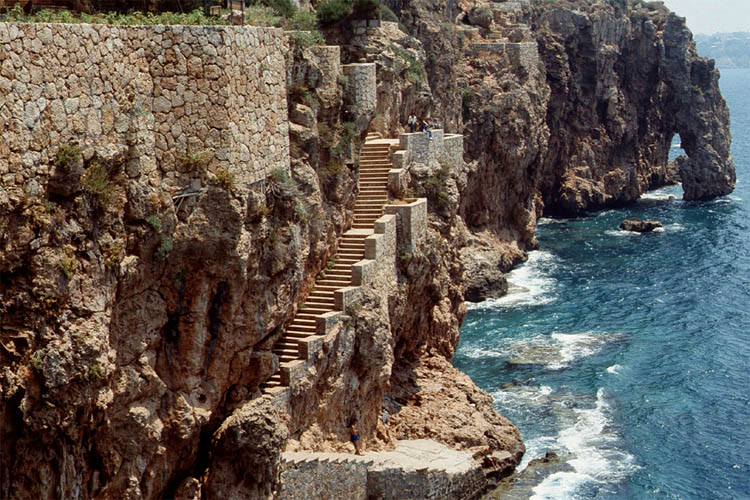
| Cliffs as far as the eye can reach
|
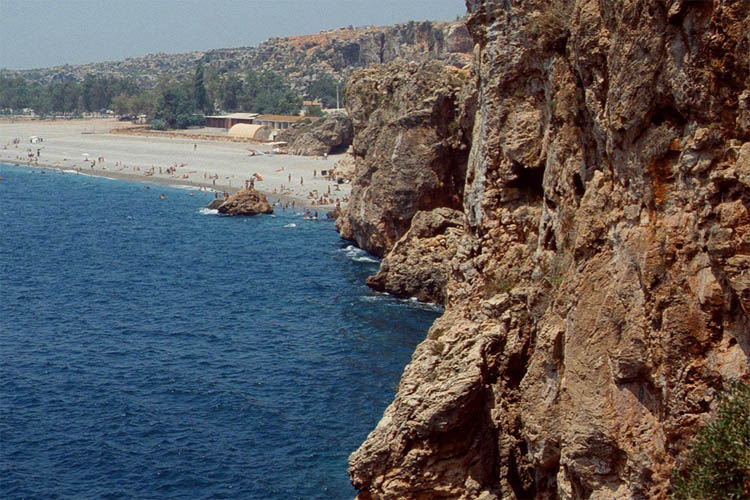
| Let's look at the beach a little bit closer
|
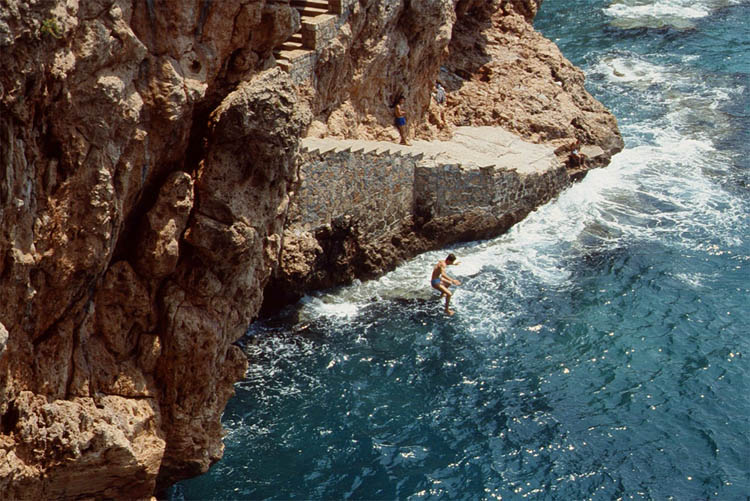
| Also more down to watch a swimmer
|

| I wouldn't jump down here
|
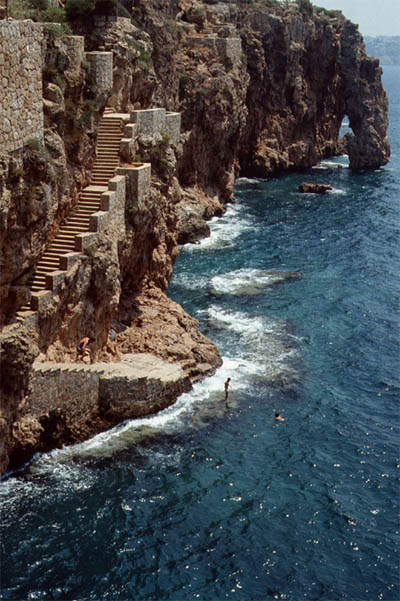
| But it's less dangerous over there
|
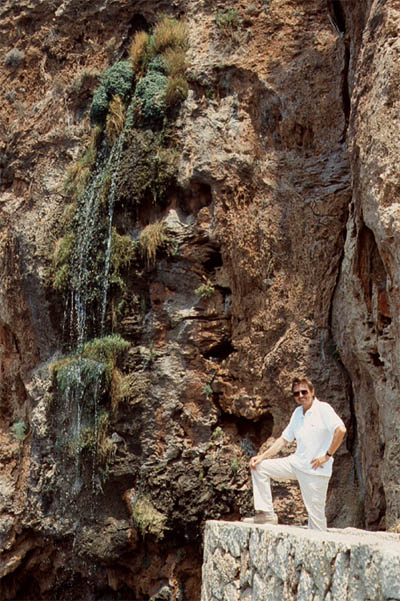
| This waterfall is very small
|
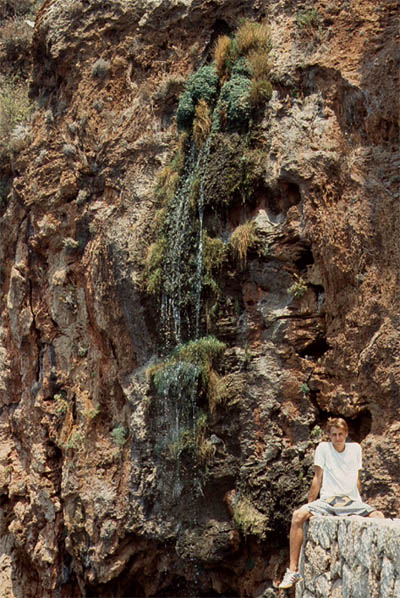
| Don't try to reach the waterfall
|

| Where's my son? He's left?
|
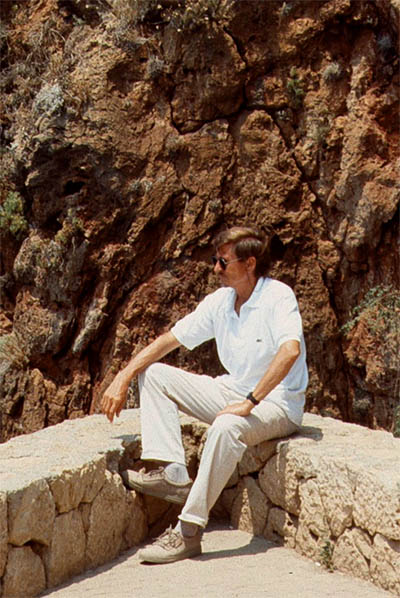
| And you think he's right?
|
The Archeological Museum in Antalya
The last thing we did before flying back home was now to finally visit the archaeological museum in Antalya. Last history lesson for Oliver. And a lesson for life?

| Let's enjoy the arts
|
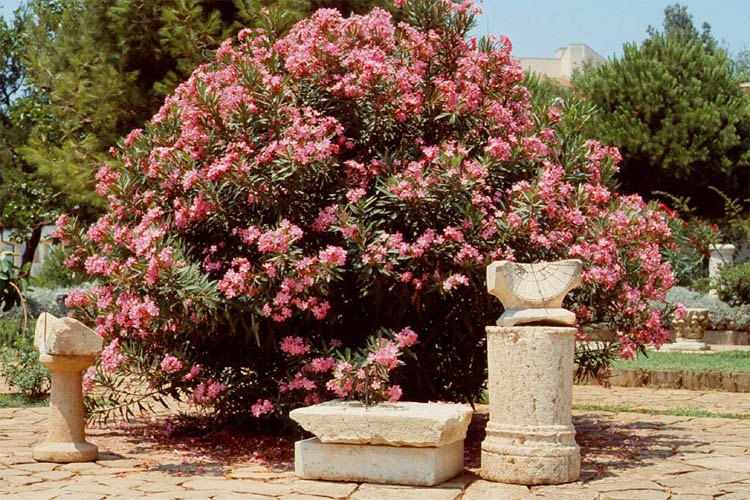
| and beautiful plants
|
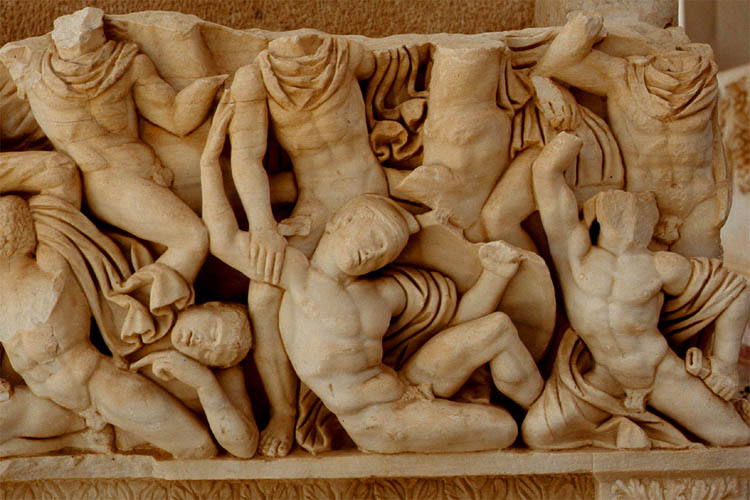
| Life may be shortened by a fight. Life is also too short to have a qualm
|

| Rather follow the Three Graces with beauty, happiness and charm
|
Ok, that was Turkey, though only a very small part of it. I could have seen and done a lot more. Also I could have written more. If you want to know more about all the places I have visited, then just look up any of the many guidebooks or in the internet.
Epilogue
I would like to know why so many historical sites had been abandoned and then neglected until they became overgrown. There might have been a reason to give up a settlement if conquered and destroyed. Or the peoples just left because the environment did not yield enough anymore to survive (climate change like droughts, natural disasters or just dried up harbors as in Ephesus, etc.).
But why did the following generations not appreciate their heritage? They even used the antique stones as construction material for their own houses, palaces, churches and mosques. That was practical. Was it also practical to use the Sphinx in Gizeh as a target in a shooting exercise by Egyptian soldiers (fortunately only the nose was shattered)?
Is it that only in our modern times we are more conscious about our world heritage? Why did get mostly the Europeans an interest in archaeology in the 19th century and later? Most discoveries were made and excavations started by them, like in Angkor Wat, Borodubur, Machu Picchu, Ancient Egypt, Troy, Ephesus, etc.
Today, many countries with such ancient treasures benefit very much from the deeds of those archaeologists. Turkey benefits in a double sense since most historical remnants had been left not by the Turks but by the European civilizations of the Greek and Romans. Without that there would be not that much tourism today and thus not that much income from Dollars and Euros.
A new fashion has been propagated recently which is to demand from European museums to return all antique artifacts to their country of origin, even if they have been acquired by either sale or exchange agreement or contract. Egypt wants that Nefertiti moves from the Egyptian Museum in Berlin to the museum of the same name in Cairo. Turkey has demanded from the Pergamon Museum in Berlin to return the Great Altar of Pergamon. Maybe it should be rather given back to Greece, since the kingdom of Pergamon was a Hellenistic state.
This is just one of the many nationalistic tendencies in some countries but generally not shared by most of the people.
The folks I met in Turkey have always been very friendly and helpful and there was no moment that I felt uncomfortable. The hospitality of the Turkish people is proverbial.
| 

























































































































